This report is part of an ongoing, multi-year study by the Tow Center for Digital Journalism at Columbia Journalism School into the relationship between large-scale technology companies and journalism.
The findings are taken from a combination of two years of original data collection, over a hundred interviews with journalists and platform executives, and three in-depth workplace studies. Results from a newsroom survey of 1,100 journalists undertaken on behalf of the Tow Center by API /NORC are also included in the study.
This research is generously funded by the John D. and Catherine T. MacArthur Foundation, Open Society Foundations, John S. and James L. Knight Foundation, Abrams Foundation, and Craig Newmark Philanthropies.
Executive Summary
By Emily Bell
The relationship between technology platforms and news publishers has endured a fraught 18 months. Even so, the external forces of civic and regulatory pressure are hastening a convergence between the two at an accelerated rate beyond what we saw when we published our first report from this study, “The Platform Press: How Silicon Valley Reengineered Journalism,” in March 2017. Journalism has played a critical part in pushing for accountability into the practices of companies such as Facebook, Google, and Twitter, yet newsrooms are increasingly oriented toward understanding and leveraging platforms as part of finding a sustainable future.
In the latest phase of our multi-year research into the relationship between platforms and publishers, we found that despite negative rhetoric and sentiment in newsrooms toward technology companies, there is a rapid and ongoing merging in the functions of publishers and platforms, and an often surprisingly high level of involvement from platform companies in influencing news production.
Technology platforms that host, monetize, and distribute news are attempting a “pivot to civics,” pushing them further into the traditional territory of news publishers as they provide more direct support for journalism and develop larger teams of editors and moderators to shape content. We’ve seen extensive and well-documented efforts to fight against a narrative that has placed them as squarely to blame for a series of failings in the information ecosystem. Platform companies have become more explicitly editorial in their own practices and structures, whether by reverting to more human “curation” of stories and feeds, or in the case of Apple News, publishing its own “exclusive” content from a newsroom staffed with writers and editors.
The perceptible change in strategy among these companies was precipitated by the spread of misinformation, scandals involving the misuse of personal data, and an ongoing funding crisis in journalism. But as technology platforms lean into the role of publisher, and become more enmeshed in the journalistic ecosystem, news organizations are showing signs of pushing back with strategies that help them retain some autonomy and control over their destiny.
In 2017 and early 2018, a series of damaging revelations highlighted the poor governance and ill-preparedness of technology companies such as Facebook, Google, and Twitter to fulfill their roles as gatekeepers of the news and information environment. From the circulation of Russian propaganda during the 2016 US presidential election campaign, to the misuse of Facebook users’ data by Cambridge Analytica, the dysfunction in the design of social media platforms and business models is now central to global policy debate.
The Tow Center research project into platforms and publishers follows the contours of this new dynamic insofar as it relates to the production of journalism. The picture for both platforms and publishers is mixed. While news organizations are just as engaged with social media as ever, we see strong signals that they are adopting a more discriminating approach to platform use, favoring bringing audiences back to their own properties over “social first” publishing.
Platforms’ mercurial behavior, and rapid changes to their own businesses, make formulating long-term strategy for publishers nearly impossible. The Tow Center has long been tracking decisions by platforms that affect publishers, from policy and product updates to monetization opportunities. We’ve observed over 600 developments in the course of our research that have, in some cases, resulted in costly outcomes for publishers. Facebook’s tendency, in particular, to frequently update and launch new products, and tweak the algorithms which surface content on its News Feed, are fatiguing publishers.
And yet, our survey data from journalists across 1,025 unique newsrooms in the United States and Canada—with 94 percent of respondents working in news outlets considered to be local—suggests that the vast majority of organizations have taken steps to adapt to this social-mediated news environment. Four in 10 journalists (41 percent) say their newsrooms have made major changes to how it produces news in response to the growth of social media platforms. About an equal share (42 percent) say their newsroom has made minor changes. Just 15 percent believe their newsrooms have made no changes to their news production routines.
At the start of our interviews in early 2016, publishers spoke about platforms with more detachment than they do today; they were distribution channels to put content in front of audiences. But in interviews conducted over the past six months, both platforms and publishers repeatedly used words like “partner” and “partnership” to describe their increasingly close relationship. We have been consistently surprised by how much newsrooms discuss with platform teams—in some cases, this includes budgets, workflow, and even the content of as yet unpublished stories. One large publisher described the evolution this way: “Now it’s becoming, ‘how do we collaborate on new products? How do we do co-sale things together?’”
This evolving partnership is unequal, however. Platforms wield more power over formats and data and earn more advertising dollars than publishers, even as platform choices increasingly inform publishers’ editorial and distribution strategies. For example, in May 2017, Apple hired its first editor in chief to oversee other Apple newsroom personnel who curate content alongside its algorithm. One news publisher told us, “We’re on Slack with the Apple editors every day. We’re pitching stories. They know what’s coming from us. They know our budget.”
While our interviews highlight the various misgivings that publishers have about relinquishing control over the publishing process to tech companies, our data suggests that publishers continue to post their content to social platforms at high volume. In tracking the platform use of 12 major publishers, the amount outlets posted to 14 platforms remained remarkably consistent over our 18 months of analysis. The total number of items posted hovered around 22,000 during each of seven, weeklong analyses, accounting for an average of 1,800 items per publisher.
We did, however, observe some consolidation in platform use, with the use of Snapchat stories declining, and Instagram (owned by Facebook) strengthening its hold on visual storytelling. The highest volume of content posts among the 12 news outlets we studied went to Apple News, Facebook, and Twitter. Medium-volume platforms included Instagram, Instagram Stories, LinkedIn, Pinterest, Snapchat Discover, Snapchat Stories, and YouTube.
Simultaneously, technology companies—most notably Facebook, Apple, and Google—have increased initiatives around more direct means of supporting journalism. Initial efforts by platforms to offer advertising opportunities through their own products have declined and been replaced by both small injections of resource and money, and the development of subscription products for publishers. As news organizations currently see the key to survival as diversifying revenue streams both on and off social platforms, the most important of those streams is reader revenue. This can include events, paid subscriptions for publishers with paywalls, and membership and donation revenue for publishers who want to keep their journalism open. Platforms by and large say they are trying to find ways to accommodate publishers, but never at the expense of their own relationship with their users.
Our key findings from this phase of research are:
- According to a survey of over 1,100 working journalists conducted in partnership with API and NORC, journalists have a conflicted relationship with social media. While the vast majority of journalists said they had adapted practices in the newsroom in response to social platforms, an overwhelming number (86 percent) felt that social media had contributed to a decline in trust in journalism.
- Half of the survey respondents said social media platforms (such as Facebook) strengthened the relationship with their audience, while 22 percent said it had weakened as a result of social media platforms; 56 percent of respondents said platforms should take “a great deal/quite a bit” of responsibility for financially supporting journalism; and 76 percent of respondents said that Facebook wasn’t doing enough to “combat the problem of fake news and misinformation” on its platform, while 71 percent said the same about Twitter, and 65 percent about Google. Facebook consistently drew the strongest criticism from publishers in all areas of our research.
- Despite the apparent toxicity of the rhetoric toward technology companies in general, and Facebook in particular, this did not appear to diminish the amount of material publishers directed through social platforms. We have, however, seen a sharp adjustment from publishers away from creating material which lives entirely on third-party platforms. As publishers practiced a “conscious uncoupling” from social media’s influence, platform companies have intensified their own efforts to remain involved in shaping the future of journalism. Whether this is a long-term strategy or a public relations initiative remains to be seen.
- Of the 12 news outlets we tracked over an 18-month period—CNN, Fox News, The New York Times, The Wall Street Journal, The Washington Post, Chicago Tribune, Los Angeles Times, New York Daily News, BuzzFeed, BuzzFeed News, HuffPost, and Vox—the larger, better-resourced publishers consistently posted more content to a greater range of platforms. The smaller outlets were almost entirely focused on Apple News, Facebook, and Twitter. This was particularly pronounced at the three regional metros, the Chicago Tribune, Los Angeles Times, and New York Daily News. By the time of our final analysis, in March 2018, just one percent of posts made by these three local publishers went outside of Apple News, Twitter, and Facebook.
- Larger publishers still have more access to platform partnership teams and product offerings than smaller and local publications. Local news publishers, in particular, have been hit hard by the loss of advertising revenue. It’s becoming clear that attempting to translate the advertising-driven business model of news publishing from print to digital by posting high volumes of content to social platforms and adopting platform-native products like Facebook’s Instant Articles—which more than half its original partners abandoned once payments to use it ran out—has been a failure. Newer efforts by technology companies, especially Facebook, to help local journalism have borne little fruit, and in some cases have been counterproductive. For instance, even the Facebook News Feed algorithm change announced in January 2018 to prioritize interactions with local news caused a steep drop off in some outlets’ website engagement figures.
- Platforms continue to shape both the style and substance of publisher content, either directly with financial incentives (Facebook has offered publishers substantial advertising credits on its platform to participate in product rollouts), or indirectly (Apple accepts pitches from publishers seeking to be featured in its news app). There are no signs that this will change. Since news broke in late 2017 that both Apple and Facebook had one-billion-dollar budgets for original programming, with Facebook reportedly offering three to four million dollars per episode of new programming and Google-owned YouTube offering two to three million dollars for the same, there has been a distinct pivot toward creating video content among the most well-resourced publishers we interviewed. One publisher told us that platforms are looking toward more “Netflix-style” deals and treating publishers like production companies.
- Current platform strategies toward news publishing are being shaped less by market forces and more by a mixture of civic duty and fear of regulation. This is leading to the adoption of much more explicit “editorial” practices, including hiring more newsroom journalists and human moderators, and active engagement in other strategies to elevate “higher-quality” news. This will inevitably lead to technology companies having an even greater influence in deciding which news publishers benefit from the environment, and what news consumers see in their feeds and search results.
- Major concerns persist over the opacity of algorithm changes, the control of the relationship with audiences, the financial support for smaller-scale journalism, and promotion, deletion, or suppression of different types of news stories.
- We anticipate much more investment from platform companies in curation, whether human or automated, and more resources directed at journalism practice. One unexpected outcome of the past two years of revelation and public debate about platform roles in news has been an expeditious cultural shift within the companies themselves.
Our research suggests that negotiations between platforms and publishers have become more mature and realistic. As the platform press grows up, however, there is still an insufficiently stable environment for a consistent supply of news at all levels. And there remain a number of outstanding issues about the power and opacity of technology companies.
While the latest earnings reports from Facebook, Twitter, and Google don’t indicate financial implications, and in fact exceeded expectations in the first quarter of 2018, we may be entering an era of reckoning for platform power. It’s becoming obvious that platforms cannot scale advertising revenue in tandem with the robust intervention needed to ameliorate the type of material they publish. Hate speech, fraudulent material, deliberate propaganda, and misinformation all grew largely unchecked in an environment where platforms did not police the content they hosted with enough rigor.
Important as it is for the business relationship between platforms and publishers to reach equilibrium if journalism is to have a sustainable future, it is not the only concern. The part platforms play in deciding how news should be distributed and their decisive role in qualitative questions about news production face a severe global challenge. As techniques for fabricating, editing, and reframing news in harmful ways develop faster than they can be detected and countered, journalism and technology companies have a strong mutual interest in finding solutions. The health of democratic debate and process rests on their ability to do so.
Introduction
It’s fair to say that platforms officially began targeting news publishers and their content as early as January 2006, when Google launched its news aggregator, Google News. (The product, however, had been in beta since 2002.) Six months after its public rollout, a Google senior vice president emailed a video presentation to the company’s CEO, Eric Schmidt, and its co-founders, Larry Page and Sergey Brin, that stated the following: “Pressure premium content providers to change their model towards free,” citing a model based on a “play first, deal later” around “hot content” and the ability “to coax or force access to viral premium content.”
Fast-forward nearly a decade to 2015 and platforms had fully pivoted toward collecting as much news content as possible into their ecosystems. Beginning in January 2015, Snapchat launched its Discover feature, which acts as an in-app magazine rack allowing publishers to deliver Snapchat-specific editions to users. This was shortly followed by the introduction of Facebook Instant Articles, Apple News, Twitter Moments, and, in December, the announcement of Google’s Accelerated Mobile Pages—a product similar to Instant Articles which rapidly loads a publisher’s stories for mobile users reading on Google. Platforms were no longer just places for publishers to distribute content in hopes of driving audiences back to their sites. They were now home to vertically integrated publishing products through which publishers could directly monetize audiences by placing ads against their news content on platforms.
Since publication of our first report from this study in March 2017, during which time the spread of misinformation and rising platform influence over editorial were key issues, publishers have fully moved into platform ecosystems. In “The Platform Press: How Silicon Valley Reengineered Journalism,” Tow Center Director Emily Bell and former Tow Center Research Director Taylor Owen concluded that a “convergence” between platforms and publishers was yielding unintended consequences. Journalism with high civic value—that investigates power or reaches underserved and local communities—is “discriminated against by a system that favors scale, shareability, and algorithms to sort and target content,” they wrote. Still, publishers continued to push more of their journalism to platforms despite no guarantee of consistent return on investment.
The “critical dilemma” publishers were facing then was: “Should they continue the costly business of maintaining their own publishing infrastructure, with smaller audiences but complete control over revenue, brand, and audience data? Or, should they cede control over user data and advertising in exchange for the significant audience growth offered by Facebook or other platforms?”
Over the last year, we’ve seen a continued increase in concern among publishers around their failure to reclaim advertising revenue vital to the news business, crafting long-term strategy amid changing platform priorities, and data privacy—especially as proof emerged that Facebook, Google, and Twitter fostered election-related meddling by Russian actors. What this means for the viability of journalism and civic participation, and who controls both, is at stake.
Methodology
The Platforms and Publishers research project, conceptualized in the late summer of 2015, began in November at Columbia University with the daylong event “Journalism + Silicon Valley.” At the heart of nearly three years of study are two research questions motivating our work: what is the current relationship between social platforms and publishers, and how has it changed newsrooms, platform companies, and audience news consumption to date? What are the future implications of this relationship?
Our deep interest in these pressing issues led us to devise a proposal for a multi-year project looking into the relationship between journalism and platforms with the aim of promoting mutual understanding and best practices for conducting journalism on the social web.
We hope to provide news publishers and journalists with a more granular understanding of how journalism and independent publishing are affected by integration with platforms, and make explicit how platform companies are having to adapt to a new role.
Interviews
Between early 2016 and early 2018, we conducted 109 interviews with individuals from 44 news organizations (representing both national and local legacy outlets, local digital, digital-native, broadcast, audio, and magazine newsrooms), six platform companies, and three industry experts. These interviews were carried out primarily over the phone, lasting 30 to 90 minutes, and were tape-recorded and transcribed. Interviewees were promised anonymity and confidentiality, and guaranteed that their responses would not be identifiable in the final results. The conversations were semi-structured, and centered mostly around editorial and revenue-related platform strategies. Because the focus of this research was publisher reactions to the evolving platform ecosystem for news, the bulk of our interviews were conducted with publishers. (See Appendix III for a detailed breakdown of interviews by type and timing.)
For the purposes of this research, we define a publisher as any organization that regularly publishes accounts and analyses of current events using a staff of journalists and editors. The size and reach of publishers in our sample varied (hyperlocal, local, regional, national, or global), as did their production formats (print, audio, video, digital-native, or platform-native) and revenue models (membership, subscription, or advertising).
We use the term “platform” to refer to technology companies which maintain consumption, distribution, and monetization infrastructure for digital media—though each is distinct in its architecture and business model. Google, for example, is a search engine, while Facebook is a social network. In both cases, the majority of each company’s revenue comes from advertising. Meanwhile, Apple makes money from hardware sales, proprietary software, licensed media, and hosted apps. All have used their technology, however, to create products for news publishers to find audiences and monetize readers within their own ecosystems. Our interviews with publishers focused primarily on Facebook (and Instagram), Google (and YouTube), Twitter, Apple, and Snapchat.
Data analysis
In an attempt to track the evolution of news outlets’ distributed content strategies, we conducted quantitative analyses of 12 publishers’ posts to 14 platforms from August 2016 to March 2018, approximately once every three months in weeklong phases.
Our content analysis was designed to include news outlets of diverse types, covering legacy broadcasters (CNN, Fox News), legacy national publishers (The New York Times, The Wall Street Journal, The Washington Post), legacy regional metros (Chicago Tribune, Los Angeles Times, New York Daily News), and digital natives (BuzzFeed, BuzzFeed News, HuffPost, Vox).
Data about the volume of posts made to the following platforms from each publisher’s main brand account (e.g., @cnn, @nytimes, etc.) was gathered over one-week periods, seven times: Apple News, Facebook, Instagram, Instagram Stories, li.st (formerly The List App), LINE, LinkedIn, Messenger, Pinterest, Snapchat Discover, Snapchat Stories, Tumblr, Twitter, Vine, and YouTube. The beginning dates of the weeklong data collection periods were: August 8, 2016; November 7, 2016; February 6, 2017; May 8, 2017; August 14, 2017; November 13, 2017; and March 28, 2018.
Where possible, data was gathered via the platforms’ own APIs. For platforms or products that did not offer public APIs (e.g., LinkedIn, Facebook Instant Articles, Apple News, Snapchat, Instagram Stories), data was either scraped via websites or collected manually.
Workplace study
In parallel to our interviews and quantitative data analysis, we also conducted a workplace study on how platforms are impacting the workflows, roles, and organizational structures of newsrooms. We studied three newsrooms in depth, interviewing 20 people in platform-related roles between January 2018 and March 2018. These interviews were carried out via video conference or in person. Supplementary interviews by phone were conducted with an additional three executives at three newsrooms in February and March 2018 to get a sense of variations in organizational structure by ownership type.
We drew on workplace-related interview material from an additional 18 interviews conducted in 2016 as part of a larger, forthcoming study (to be published independently) for a sense of how the context of platform roles had changed. Our analysis paid particular attention to the dynamics of bridge roles—the people who work in between business and editorial functions in groups like audience engagement, social media, and product. It’s these people who are often in the position to notice, interpret, and implement changes in social platform functionality.
Journalist survey
The Tow Center developed a questionnaire in consultation with the American Press Institute, which was used by NORC at the University of Chicago to conduct a survey across local and national newsrooms in the United States and Canada focusing on journalists’ perceptions of platform companies and their relationship with them. Spanning six weeks, between March 1, 2018 and April 12, 2018, there were 1,127 respondents to the survey from 1,025 unique newsrooms across multiple media outlet types (local newspapers, local TV stations, magazines, digital-only, etc.). Ninety-four percent of the respondents were working in news organizations primarily considered to be local, with the rest from national outlets. All survey respondents had roles in the newsroom, including (but not limited to) as editors, reporters/writers, producers, and hosts/anchors. The topline findings and detailed methodology are available in Appendix II of this report.
Focus groups and policy exchange forums
As part of this research, we also ran a series of focus groups with news consumers in four cities to explore the changing context of consumption behavior, and whether and how the shift to social distribution is being registered as a concern among news audiences. Focus groups were attended by 58 residents from Bowling Green, Kentucky; Elkhart, Indiana; New York, New York; and San Francisco, California. Among the key findings were that audience members often had simplistic and/or inaccurate understandings of the algorithms that surface news on tech platforms; they felt local news was often less visible in their news feeds; and audience members intrinsically linked fake news to social platforms.
In addition, the Tow Center convened four policy exchange forums aimed at examining the emerging implications of social distribution for four areas of publishing policy and technology: artificial intelligence, advertising, content moderation, and archiving. During these sessions, participants representing both the platform and publishing sides of the news industry engaged on issues related to the ethical and civic values of journalism. The forums were closed, by invitation only, and followed the Chatham House Rule providing anonymity to speakers. The summary of findings from the first two were published independently, with the others forthcoming.
State of an Uncomfortable Union: The Platform-Publisher Relationship
Platform companies are now at the core of every stage of the publishing process, from newsgathering and editorial strategy, to distribution and communication with audiences, to monetization. This marks a qualitative shift from when our study began.
From distribution to product partnerships
At the start of our interviews, in early 2016, publishers spoke about platforms with more detachment than they do today: these were distribution channels to put content in front of audiences. The sentiment worked both ways. At the Tow Center’s “Journalism + Silicon Valley” conference in November 2015, Facebook’s then-product manager for Instant Articles, Michael Reckhow, said, “We think of our readers as the customers we want to serve with great news—and then with publishers, we also treat them as customers … that’s the language we use because I think that explains the role we play.”
But in interviews we conducted over the past six months, both platforms and publishers repeatedly used words like “partner” and “partnership” to describe their increasingly close relationship. While it’s unclear which side first pushed this more intimate vocabulary, it fits. The relationship between the two has evolved from one based on simple distribution to one built around product opportunities. One large publisher described the evolution this way: “Now it’s becoming, ‘how do we collaborate on new products? How do we do co-sale things together?’”
Accordingly, there’s been a notable increase in the frequency and type of communication between platforms and publishers as both sides formalize the management of these relationships. It was clear from our interviews with larger, well-resourced news organizations that their platform interactions happen across multiple departments, and generally more frequently than with smaller publishers who might only interface with a platform’s product support team. One larger publisher told us:
“Platforms used to primarily anchor their relationship with publishers around the distributing of content on their platforms. The platforms have gotten smart to the fact that several partners need the benefit of interfacing with multiple parts of their company. As a result, I’ve noticed that some of the big platform companies have worked to create more central, holistic management of touchpoints across their organizations.”
In interviews, we heard a growing list of terms among publishers that accompany these new relationships:






Overall, while the specifics (including the platforms interacted with, and the format and frequency of those interactions) varied from publisher to publisher, in our interviews many spoke of weekly and monthly calls and in-person meetings, as well as routine trainings around best practices or specific products. Apple News, for one, has increased in importance among publishers, and many larger outlets are in frequent contact with its newsroom. One publisher said:
“We’re on Slack with the Apple editors every day. We’re pitching stories. They know what’s coming from us. They know our budget. They tell us when they have opportunity for certain kinds of collections or curations and [ask] if we have anything that would fit that bill. We don’t contort ourselves, but certainly if there’s an opportunity [to be showcased on Apple News] we think about: does it make sense for us, editorially?”
The uneven power balance
This evolving publisher-platform partnership is unequal, however. Platforms wield more power over formats and data, and earn significantly more advertising dollars in aggregate than publishers, even as platform choices increasingly inform publishers’ editorial strategies, distribution strategies, and workflows. One larger publisher told us that when they meet with a platform’s business department to discuss direct monetization opportunities, these types of meetings can be “fraught,” because they directly involve revenue.
This publisher said, “Platforms come in and say, ‘Here’s what we’re launching. Here’s how it’s going to work. Here’s how you can participate.’ They never once asked, ‘How do you see this working for your businesses?’”
If news outlets were once cautiously optimistic about what their relationships with platforms might yield, that has now turned to seasoned skepticism. As one publisher told us, “Platforms are proactively getting in touch a bit more. They’re getting more active about scheduling meetings and check-ins. … There is more receptiveness towards getting more involved, though that doesn’t necessarily always mean a greater flow of information or answers to all questions that we ask.”
Publishers remain frustrated by the inconsistency and depth of audience insights and analytics provided to them by platforms. And even as platforms cede select additional data to publishers, including, for example, the change Facebook made in May allowing publishers to see whether video viewers are followers or non-followers and “audience retention by gender,” one platform told us that they “draw the line” on providing audience insights to publishers where “it’s competitive information for us.”
Platforms by and large say they are trying to find ways to accommodate publishers, but never at the expense of their own relationship with their users. One platform described a certain publishing product rollout, saying, “It was not really outreach to the news industry as much as it was trying to fix a user problem.”
How publishers use these platforms
Our content analysis data shows that since early 2016 platforms have become central to where and how audiences find news content. While our interviews highlight various misgivings that publishers have about relinquishing control over the publishing process to tech companies, our data suggests that publishers continue to post their content to social platforms at unwavering rates.
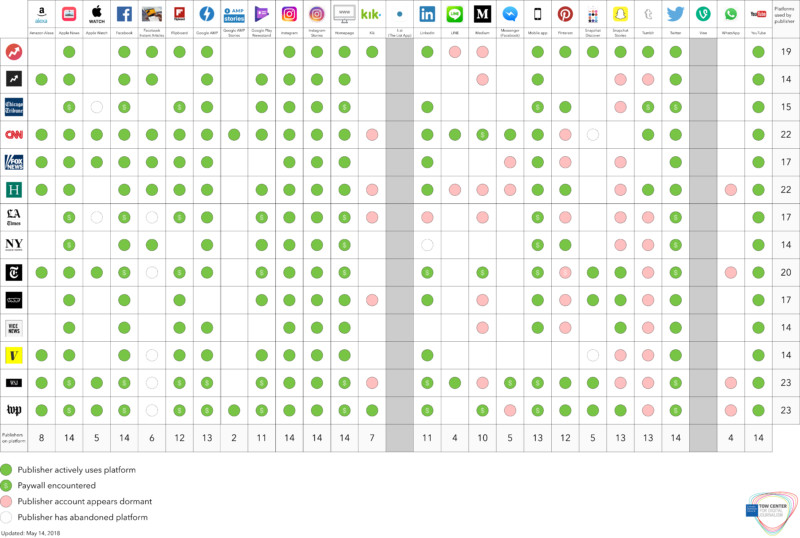
In tracking the platform usage of 12 major publishers, the amount and frequency these news outlets posted to 14 platforms remained remarkably consistent over the 18 months of our analysis. The total number of items posted hovered around 22,000 during each of seven weeklong phases of study, accounting for an average of 1,800 items per publisher.
This rate of third-party publishing continues even as many news outlets are realizing they cannot win the scale-based game that seeking sustainable digital ad revenue requires. Currently, more than 70 percent of all US digital ad revenue goes to Google and Facebook. And these gains do not appear to have been shared: a recent study of the digital revenue composition of 21 large publishers revealed that earnings from Google and Facebook represented only five percent of the average total.
Platform Usage by the Numbers
Chart 1 shows the number of different platforms used by publishers in our study during each of seven weeklong phases of analysis beginning in August 2016 and concluding in late March 2018. The platforms included in our study were Apple News, Facebook, Instagram, Instagram Stories, li.st (formerly The List App), LINE, LinkedIn, Messenger, Pinterest, Snapchat Discover, Snapchat Stories, Tumblr, Twitter, Vine, and YouTube.
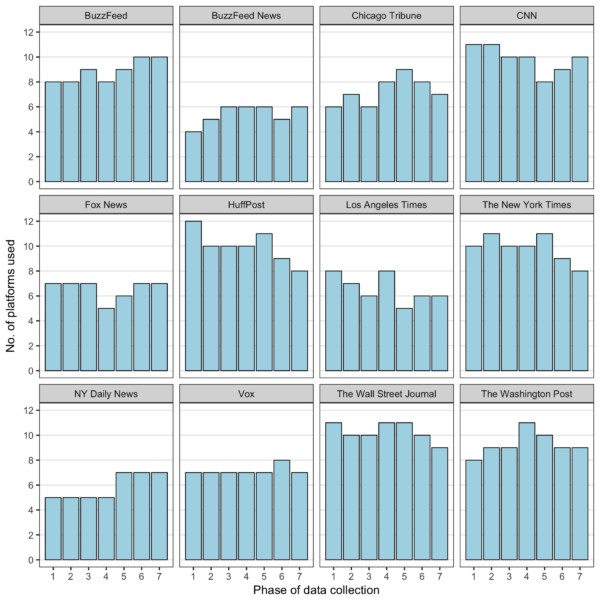
Chart 1: The number of different platforms publishers used during each phase of data collection (August 2016–March 2018).
All publishers posted to multiple platforms during each week of analysis—with many frequently posting to 10 or more. BuzzFeed News’s use of four platforms during the earliest phase of analysis, in August 2016, was the lowest observed.
The highest number of different platforms employed in a week was 12 by HuffPost in November 2016 (Apple News, Facebook, Instagram, Instagram Stories, LINE, LinkedIn, Messenger, Pinterest, Snapchat Stories, Tumblr, Twitter, and YouTube). CNN and The Wall Street Journal both used as many as 11 platforms on different occasions, and The Wall Street Journal never used fewer than nine.
CNN, HuffPost, The New York Times, and The Wall Street Journal all used an average of 10 platforms per week, closely followed by BuzzFeed and The Washington Post with nine. The three local publishers—the Chicago Tribune, Los Angeles Times, and New York Daily News—were at the lower end of the scale, typically using six to seven platforms per week.
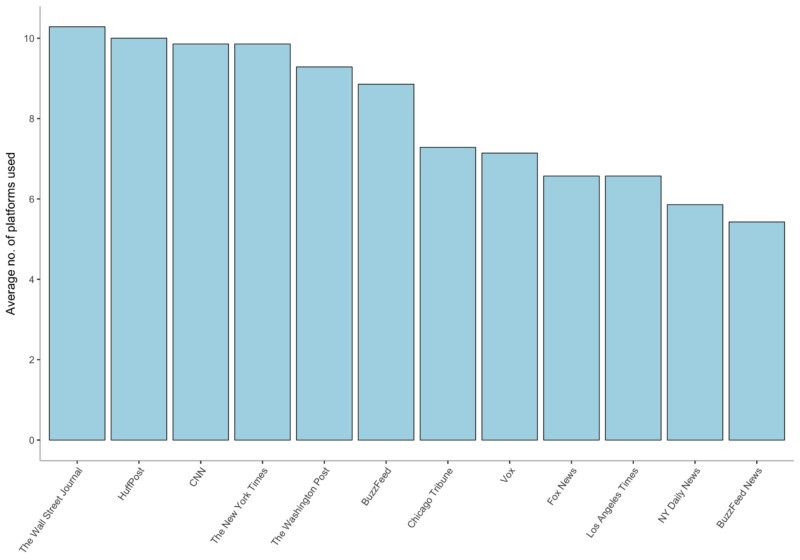
Chart 2: The average number of platforms used by each publisher per phase across all seven phases of data collection (August 2016–March 2018).
Assessing platform use highlights the indispensability of Apple News, Facebook, Instagram, and Twitter to these 12 publishers. YouTube and Instagram Stories were not far behind, but most others were used far more selectively.
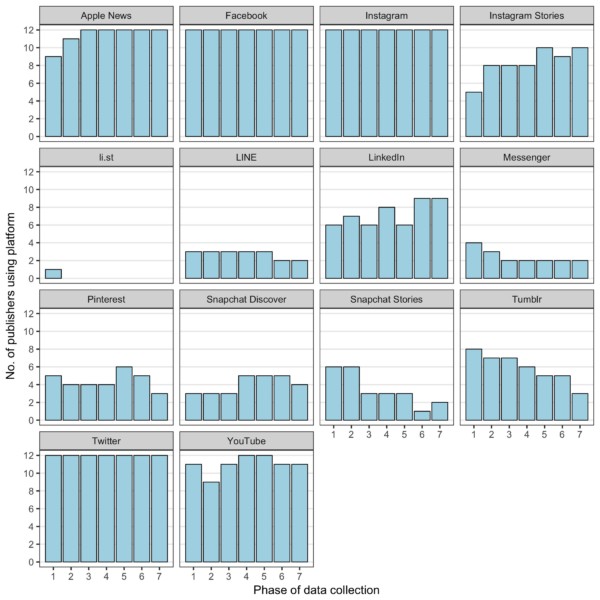
Chart 3: The number of publishers using each platform during each phase of data collection (August 2016–March 2018).
Apple News, Twitter, and Facebook dominated—particularly at the regional metros. For every publisher, the amount of content posted to Apple News, Twitter, and Facebook dwarfed that distributed to the 11 other platforms we tracked.
This was particularly pronounced at the three regional metros—the Chicago Tribune, Los Angeles Times, and New York Daily News. By the time of our final analysis, in March 2018, just one percent of posts made by these three regional publishers went outside of Apple News, Twitter, and Facebook.
This is in stark contrast to some of the other publishers. For example, around 20 percent of posts made by two of the digital natives—Vox (22 percent) and BuzzFeed (20 percent)—went to platforms outside of Apple News, Twitter, and Facebook. These were closely followed by the three bigger, more-resourced publishers—The New York Times (17 percent), The Wall Street Journal (15 percent), and The Washington Post (15 percent)—all of which continued to try and reach their audiences in different places with posts across a wider variety of platforms.
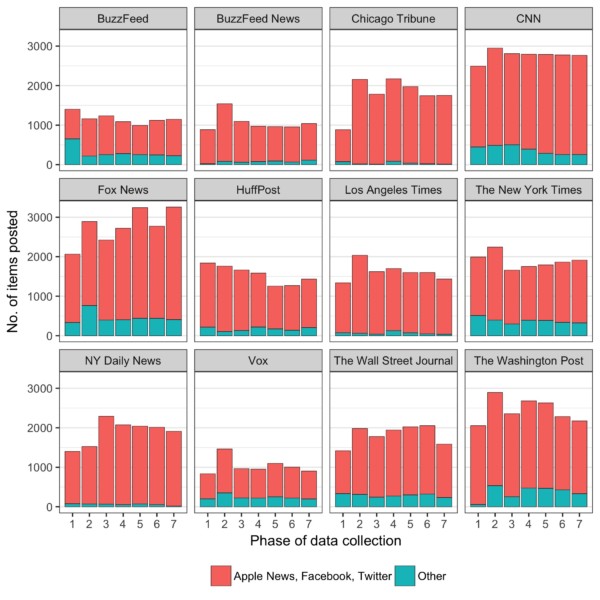
Chart 4: The proportion of posts made to Apple News, Facebook, and Twitter (red) versus the other 11 platforms studied (August 2016–March 2018).
Informing editorial and newsroom strategy
Platform audience insights and priorities both factored heavily into the types of stories commissioned by publishers we spoke to, and also the formats through which those publishers chose to tell stories. Anything from, for example, platform data provided about average video view time to Facebook’s decision to promote Live video in its News Feed, informed publishers’ editorial choices. One publisher noted that audiences on Facebook would watch videos longer if they opened with a climax that traditionally comes later in the video, so the publisher began to produce videos that way.
Platforms’ quickly changing priorities, however, make formulating long-term strategy for publishers nearly impossible. The Tow Center has been tracking decisions by platforms and platform-related events that affect publishers, from policy and product updates to monetization opportunities, and we’ve observed more than 600 developments in the course of our research that have accumulated and, in some cases, resulted in costly outcomes for publishers.
Platform Changes Informing Newsroom Strategy
The power of platform decisions to influence publishers’ distributed strategies can manifest in a variety of ways.
When Apple News introduced a paywall facility in September 2016, the number of articles posted to the platform by subscription-based publishers such as the Chicago Tribune, Los Angeles Times, and The Wall Street Journal shot up. Apple News has a massive potential audience and the introduction of a paywall offered a new source of potential income for publishers.
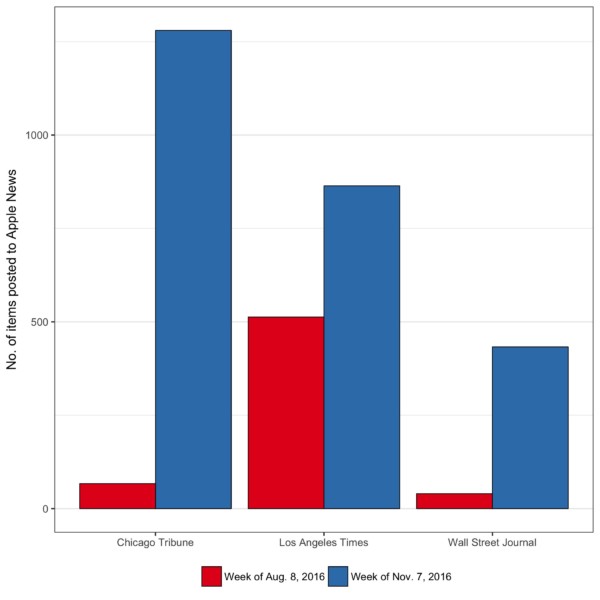
Chart 5: The number of articles posted to Apple News in weeklong periods before and after the paywall facility was introduced.
Platform changes also influenced publishers’ distribution strategies in other, more subtle ways.
For example, when Instagram rolled out an update increasing the maximum length of videos from 15 to 60 seconds, the number of videos published to the platform by Fox News jumped substantially and near immediately.
Unlike the Apple News paywall, or publishers opting in to new products like Facebook Instant Articles, this uptick in usage was not about exploring potential sources of revenue—as Instagram does not offer any kind of revenue share. An increase in Instagram posts was purely a brand play.
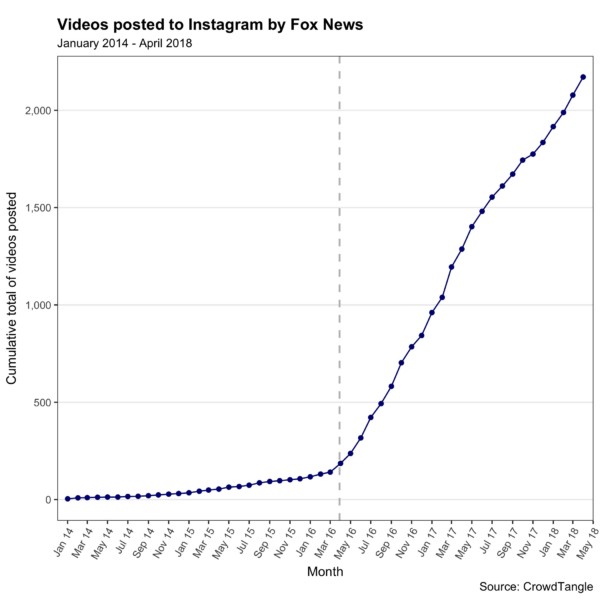
Chart 6: Videos posted to Instagram by Fox News (January 2014–May 2018).
In the 27 months spanning January 2014 to March 2016, Fox News posted an average of five videos to Instagram per month. In the 24 months after the maximum video length increased to 60 seconds, beginning in April 2016 and running through March 2018, the monthly average increased 1,520 percent to 81 per month.
The 156 videos posted in March 2017 alone—an average of five per day—equates to 15 more than were posted in the 27 months prior to the introduction of one-minute videos.
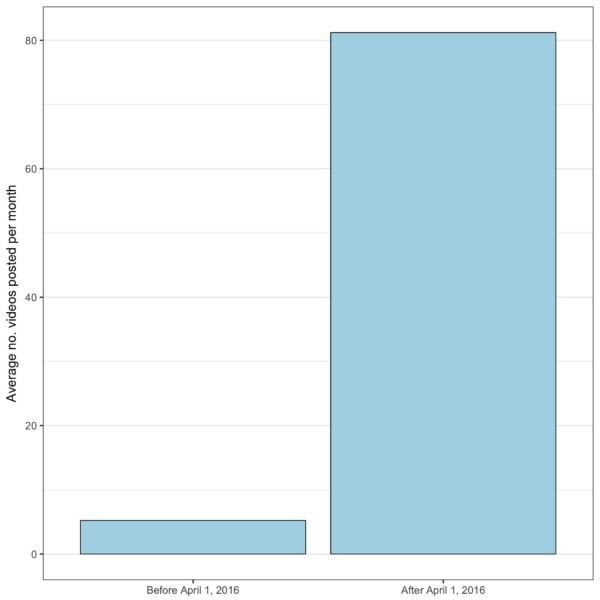
Chart 7: The average number of videos posted to Instagram by Fox News before and after Instagram increased the maximum video length from 15 seconds to one minute.
Audio is emerging as the newest example of the continuing power of platform products and priorities to influence editorial strategy. With the availability of Amazon’s Echo and Google’s Google Home Assistant—and with Facebook soon introducing its own smart speaker—publishers are beginning to rethink content creation based on new formats and audience behavior on smart speaker platforms. Just one month after the May 2017 launch of Amazon’s new video-enabled smart speaker, the Echo Show, CNN, Time Inc, and Bloomberg already had content in the works.
Designing news content that fits the home speaker platform is not straightforward, though. In one interview we conducted, an audio publisher noted the challenge of creating output for smart devices that live in intimate spaces, like the bedroom:
“The adoption in smart speakers is really bringing radios back to those counters and bedside tables and everywhere else in a way that is terrifically promising. Where user behavior goes next is a big open question. Are people going to really learn to talk to these speakers? Will they become trusted companions? … It’s something where we’re investing a lot of time and energy right now because we do believe there’s a lot of audio opportunity and content opportunity on those platforms.”
Publisher pushback
Despite a trend that sees publishers tailoring news outputs to platform products, which we observed beginning in our 2016 interviews, in some cases publishers are becoming more cautious about how and when they adjust editorial strategy to fit platform requirements.
One said, “I think the platforms started influencing content creation because they rewarded a certain type of content. That made everyone want to maximize that and create stuff the same way. Over time, though, once publishers realized that this contract with the platforms wasn’t going to pay off the way they thought it would, it became a little bit of ‘back to the basics.’”
A digital-native publisher reflected, “Platforms don’t always reward the best behavior. So you can end up in a rabbit hole where you look at your product in the rear-view mirror and think, ‘Is that what I intended to create?’” Even these publishers that once thrived by conforming almost entirely to platform priorities are increasingly asking, “How do we match up what we consider important journalism with extreme audience optimization … those things don’t always click.”
Still, ad-supported digital-native and platform-native publishers remain the most inclined to be directly responsive to platform interpretations of what users want. One said, “Publishers will talk as if Mark Zuckerberg is literally the Wizard of Oz, the man behind the curtain, [who is] going to suddenly point all of the audience at a thing, or away from [it].” The publisher added: “We are very concerned with what the audience is telling us they want more of. Not every publisher is that type. For some publishers it’s all about writing for the right audience. Our interests are in talking to bigger audiences. So if you’re going to do that [as a publisher], then you need to pay attention to what people want.”
One question remains central to this struggle: to what extent are platforms reflecting user desires versus shaping user behavior? One local publisher reflected on the day-to-day nature of this tension: “There are, I believe rightly so, conversations we have internally about if we’re doing a story because we think it’s going to do well on social. Do we think this is going to be a win on Facebook? Is that the reason we’re posting this story?”
Facebook dominance and discontent
Throughout our research, Facebook has remained for the majority of publishers we interviewed the top platform for reaching and engaging audiences, and for subsequent monetization opportunities. It continues to dominate every part of the digital publishing value chain. Its publisher products are not only for distribution and audience engagement (e.g., Instant Articles), but also for production (e.g., Live), and for multiple forms of monetization (e.g., the Audience Network, which allows publishers to insert ads from Facebook’s ad network into, for example, their Instant Articles as the platform acts as a sort of middleman between publishers and brands).
Facebook, therefore, has had more touchpoints with the publishing industry than other platform companies. Because of this prominence, publishers expressed more frustration toward Facebook than any other platform—and those frustrations are mounting. As one publisher put it, “The other social platforms, like a Twitter or a Snapchat or a Reddit, I think we don’t get as angry with them because our business isn’t affected by them as much.”
While Google has collected more user data and captured more digital ad revenue than Facebook, there are crucial factors which differentiate the two platforms with regard to publisher usage—and which explain publishers’ most common reactions to Facebook. The Facebook user experience is designed to keep audiences on the platform, displacing control over audiences and monetization from publishers. Google’s search and news products, on the other hand, connect readers to publishers’ content across the open web by pointing traffic at publishers’ own sites and article pages.
Though Google’s PageRank is no longer public, publishers generally know the types of inputs to the algorithm and how to optimize their digital content for Google search. Facebook’s News Feed algorithm, by contrast, is mostly a black box. Publishers hear when the News Feed is, for instance, prioritizing video one month and posts from friends and family another. But the only way for a publisher to ensure prominence in users’ feeds is to pay for placement via promoted posts.
Our interviews with publishers, therefore, indicate two major areas of discontent with Facebook. First, publishers are frustrated by frequent changes regarding the platform’s products and how they are prioritized and monetized—since this has a direct impact on newsroom workflow and revenue outlook. Because Facebook is a platform built around fostering and monetizing on-site user engagement, it cares deeply about the functionality and relevance of its product to its users. This central concern with the user-product relationship—and the product-advertiser relationship—means that Facebook engages in frequent product updates and new product rollouts to test ways to keep users on the site and help advertisers locate new customers.
One publisher nicely summarized the sentiments of many others around the volume of changes: “Now I think everyone is kind of getting frustrated. We’re not going to change our workflow entirely because of something Facebook is changing.” Another publisher, commenting on the specific product changes which publishers have had to navigate, said, “Pivot to live, pivot to video, pivot to groups. You know, at some point, people are going to just get a bit tired.”
Additionally, publishers struggle with what they perceive to be opacity and capriciousness around the News Feed curation algorithm. In our earliest interviews, publishers wrestled with just how much to allow Facebook’s algorithm—a reflection of its priorities when surfacing popular and engaging content—and audience insights to factor into editorial strategies. Lighter content, or “soft news,” is easier to like, share, or react to, and generally performs better on a platform like Facebook. As one publisher put it, “A major news brand can’t say, ‘Our audience doesn’t care about Haiti right now unless Trump calls it a shithole’ … You still have to put it [on Facebook].”
Even in more recent interviews, there has continued to emerge a language of helplessness around the News Feed algorithm. Though Facebook has signaled increasing openness to collaboration and feedback on other parts of its product, the News Feed remains a closely guarded component of the platform. One publisher described the effect of shifting News Feed priorities as “riding these traffic waves and hoping that the height of the wave this month is sufficient to keep the lights on.” And because the News Feed algorithm is not designed to build loyalty to a single publisher, but to tailor individualized streams of content and advertising for the Facebook user, publishers described reluctantly having to “pay to play,” meaning pay to promote posts in order to ensure that their content reaches a News Feed audience.
A month after Facebook made yet another significant change to its News Feed, in January 2018 to de-prioritize news in favor of more “meaningful interactions with family and friends”—one that particularly threatened the livelihood of some smaller publishers and forced at least one to shut down—Facebook’s publisher-wrangler-in-chief Campbell Brown shrugged at disgruntled newsrooms, saying, “If someone feels that being on Facebook is not good for your business, you shouldn’t be on Facebook.”
Despite rising disillusionment, many publishers continue to maintain cordial relationships because they do not want to miss out on new product rollouts or other opportunities. One national publisher described wanting “to be in Facebook’s good graces.” Another local publisher was more resigned, saying, “We feel like we can’t afford to be critical, because God forbid there is some sort of resource or benefit that we need to be considered for down the road.”
A handful of publishers, however, have come to Facebook’s defense. Their view is that Facebook is too often the scapegoat for all of news publishers’ revenue and audience problems, and that news outlets expect more than they should from platforms—more than they might give if the tables were turned. In our initial interviews in 2016, one national publisher said:
“I know there’s a desire to put them in the good or bad bucket, but I feel like every time we have a conversation about Facebook there’s this need to ascribe intent. Do they have good intentions or bad intentions? But I just don’t think it’s either or. I think they are very focused on making sure they have an engaged audience that continues to grow and invest in Facebook, and they need publishers to continue to build out that ecosystem. They’re definitely not going to put the publisher needs and desires first. They’re putting the Facebook audience needs and desires first.”
In recent interviews, a local publisher said of frustrations with Facebook’s news partnerships team, “I think people sometimes forget that those who can make things happen are not necessarily the people we’re talking to. It’s people above them who have to make decisions that fit into Facebook’s overall strategy, and I doubt they’re going to pick something that hurts them to help us.”
However, when it comes to Facebook’s dominance in publisher complaints, it could also be that publishers have short memories. After all, it was Google’s First Click Free policy that initially upset publishers looking to reach audiences online. First Click Free raised a generation of internet users on free news, and conditioned users’ willingness to pay down to almost zero. This rock-bottom readiness to pay played a role in the evolution of digital publishers’ business models toward the focus on advertising and social scale; it is also one of the major challenges publishers face in pivoting to reader revenue through subscriptions and donations. Though Google has recently abandoned First Click Free, and now allows publishers to choose how many articles to allow Google users to read before they hit a publisher’s paywall, it remains to be seen how the partnership between publishers and Google will take shape in the wake of Facebook’s PR problems.
Local News and the Diverging Experiences of Smaller Publishers
Local news publishers in particular have been hit hard by the loss of print advertising revenue, and in our initial interviews in early 2016 felt de-prioritized by platforms and cut off from these potential new monetization opportunities. One local publisher told us then that platforms were taking a “class-based approach.” Small publishers felt left out of early platform products like Instant Articles and Snapchat Discover, and, in many cases, still don’t have the resources to experiment or participate with new products like Facebook Watch, a section of the platform for video on demand shows that launched in August 2017.
One local publisher asked, “In newsrooms where your workforce is shrinking basically every year, is it worth it to spend time on an Instagram Story?” Another local publisher said, “Apple News is not picking up the phone and saying, ‘Hey, would you like to be a partner with us?’ So being a little fish in a big pond, sometimes we can get skipped over. Sometimes we have to go the extra mile to get in on the newest thing.” Yet another local news publisher said, “We still don’t have the staff in place to do the kind of journalism that people are looking for on these platforms now … we don’t have the people to build the kind of content that these social media platforms want to bubble up.”
Exclusion from platform opportunities
Platforms consistently privilege larger publishers, who generally hear about monetization opportunities first and have more access to platform partners. As platforms expand their offerings, publishers who don’t fall into this group can still ingratiate themselves with new platform initiatives if they align with a platform’s product development goals at any given moment (for example, a local publisher with a paywall might be asked to join a test of Facebook’s subscription product, but is unlikely to see outreach from Twitter to create a show for the platform).
In platforms’ initial rollout of publisher products, audio publishers were also shut out. In our early interviews one audio publisher described creating a workaround to the Facebook video player to get audio prioritized by Facebook’s News Feed algorithm. Another audio publisher said, “The main platforms are all so concerned with video and visuals and text, it’s been hard to convince them otherwise.”
One factor explaining the disparity in publisher experiences vis-à-vis platforms is larger publishers’ ability to manage more sophisticated relationships, and the return on investment that platforms see in those publishers. As one national publisher put it, “Some of the bigger publishers have always had good business development teams and abilities to manage that ongoing relationship, because it’s not exactly editorial. It’s a combination of editorial and business value that you’re constantly exchanging with these platforms.”
A local publisher described “clawing and scratching and screaming” to get platform attention while a large publisher acknowledged that due to its size and audience “[platforms] come to us with more opportunities and therefore we take advantage of those opportunities … it’s a virtuous circle.”
Disparity in platform usage
Our data shows that the larger, better-resourced publishers consistently posted more content to a greater range of platforms. The smaller outlets were almost entirely focused on Apple News, Facebook, and Twitter. This was particularly pronounced at the three regional metros, the Chicago Tribune, Los Angeles Times, and New York Daily News. By the time of our final analysis, in March 2018, just one percent of posts made by these three regional publishers went outside of Apple News, Twitter, and Facebook.
Volume of Content/Diversity of Platforms Used by Publisher Size
Assessing the distribution of posts on a publisher-by-publisher basis, it is useful to compare the lesser-resourced newsrooms with their larger counterparts.
Take, for example, the Chicago Tribune, Los Angeles Times, and New York Daily News—all dominated by three colors in Chart 8 representing Apple News, Facebook, and Twitter—with the multicolored charts representing the likes of CNN, The New York Times, The Wall Street Journal, and The Washington Post.
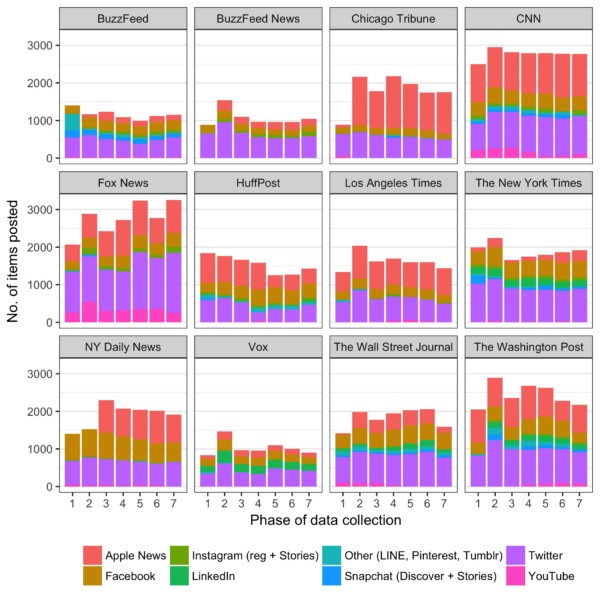
Chart 8: Total number of posts made by each publisher during each phase of data collection, separated by platform.
If distribution is about meeting audiences where they already are, then data shows how bigger publishers have the ability to pump out more content to a wider variety of destinations (thereby increasing the chances of meeting more people in more places), while the lesser-resourced ones are forced to prioritize certain platforms—Apple News, Facebook, and Twitter, in particular—while making rarer, more sporadic posts to other platforms when time or resources permit.
Comparing the two New York-based titles, for example, there is stark contrast between the rainbow of colors in The Times’s distribution chart and the almost tritone equivalent produced for the Daily News.
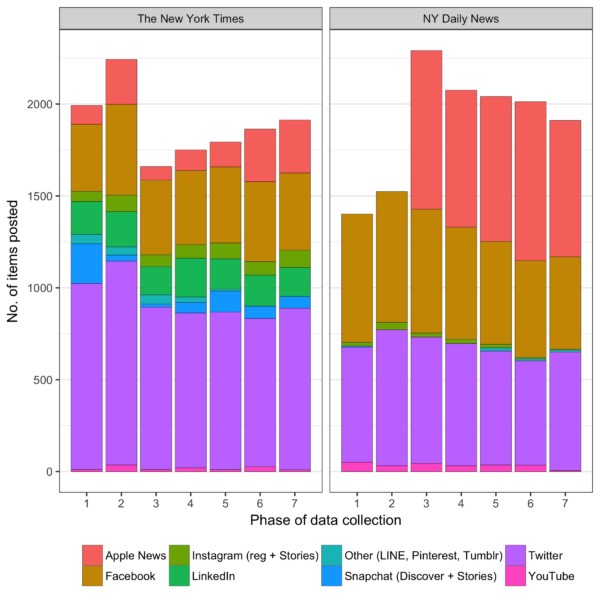
Chart 9: Comparing the destinations of platform posts made by The New York Times and New York Daily News.
Concern for the health of local news and the promise of platform help
Platforms are, however, increasingly turning some of their attention toward the needs of small and local publishers. Since the 2016 presidential election, as questions around an informed public and democracy came into the spotlight, some platforms have been more inclusive of small and local newsrooms in product rollouts, and have launched initiatives to support local news.
The 300-million-dollar Google News Initiative, which houses news-related efforts like partnerships with nonprofit organizations that represent local media, and Facebook’s Local News Subscriptions Accelerator, which promises to help a dozen or so news organizations gain digital subscribers, both launched in the first months of 2018.
However, our data and survey findings suggest that publishers remain wary. According to the API/NORC survey, most of the skepticism (by journalists working at local and national news organizations) is reserved for Facebook—with only seven percent of the respondents saying they think the company is “extremely sincere” or “very sincere” about wanting to help journalism and journalists. Still, neither Twitter nor Google had particularly flattering numbers, with 10 percent of respondents believing the same of Twitter and 13 percent of Google.
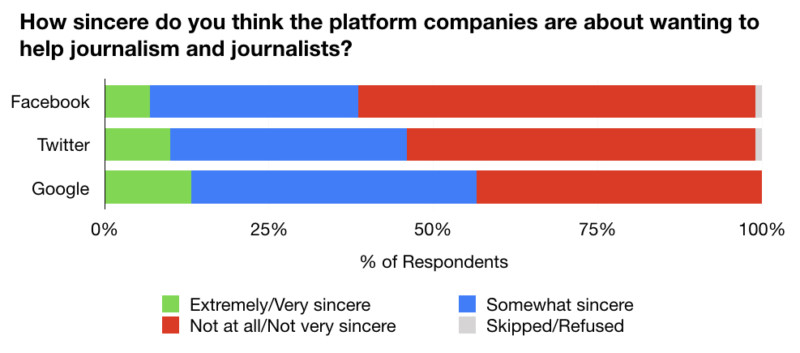
Publishers we interviewed who participated in one of Facebook’s recent local news initiatives found their involvement to be frustrating and ineffective. One participating publisher said, “There’s all this PR speak about the importance of local journalism, but when it comes down to it [the platforms’] actions do not align with that.” Another local publisher said, “Facebook always puts out a fat mic: ‘we’re here for you, we’re here for journalists.’ But ultimately getting in touch with them is very difficult. Getting a straight answer out of them is difficult.”
Furthermore, although both Google and Facebook have made public statements about prioritizing local news, some local publishers noted that the platforms’ algorithms will often surface national or aggregated takes on stories they break. One local publisher said, “That is something that completely chaps my ass routinely—when I see people [locally] sharing national versions of stories that were broken by my news organization. It just makes me lose my mind.”
In late January 2018, Facebook also promised local newsrooms that a change to its News Feed algorithm would prioritize local journalism. Mark Zuckerberg posted on his personal Facebook page: “Today our next update is to promote news from local sources. People consistently tell us they want to see more local news on Facebook. Local news helps us understand the issues that matter in our communities and affect our lives. Research suggests that reading local news is directly correlated with civic engagement. People who know what’s happening around them are more likely to get involved and help make a difference.”
As Tow researcher and report author Pete Brown wrote for CJR in April 2018, based on analysis of 13 regional metros both before and after the algorithm change, Facebook “is already missing the mark on one of its central goals for 2018: giving local news a shot in the arm.”
Our data indicates that Facebook interactions with local journalism posts are down by as much as 56 percent compared to the two years prior, as 11 out of 13 regional metros averaged fewer interactions per post in the nine weeks following the pro-local algorithm change than in the two years before.
Local News and the Facebook Algorithm Change
To assess the impact of Facebook’s January 29, 2018, algorithm change to promote “meaningful interactions” with local news, we evaluated 13 regional outlets—chosen because they participate in Facebook’s Local News Subscriptions Accelerator. Data was collected from CrowdTangle (the monitoring tool now owned by Facebook) on Tuesday, April 3, 2018. It covers the period between January 1, 2016, and April 1, 2018. Interactions were calculated by summing reactions (likes, hahas, etc.), shares, and comments for each post. (This research does not assess the success of the Local News Accelerator, which Facebook announced in February to help news organizations gain subscriptions.)
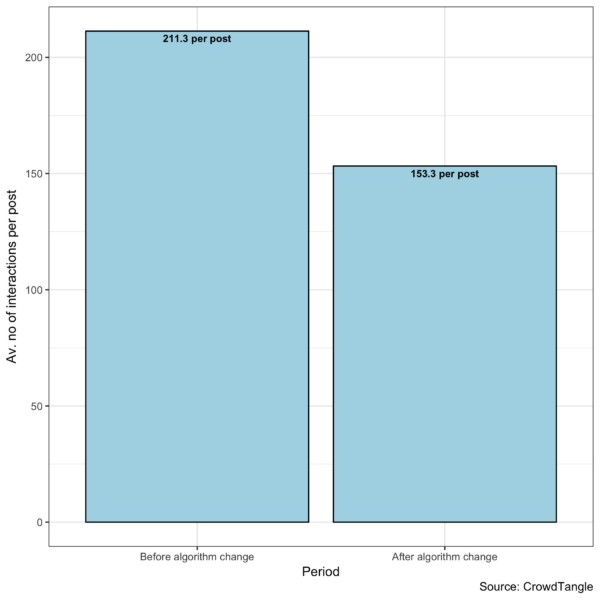
Chart 10: Average interactions with Facebook posts before and after the pro-local news algorithm change (January 1, 2016–January 28, 2018, versus January 29–April 1, 2018).
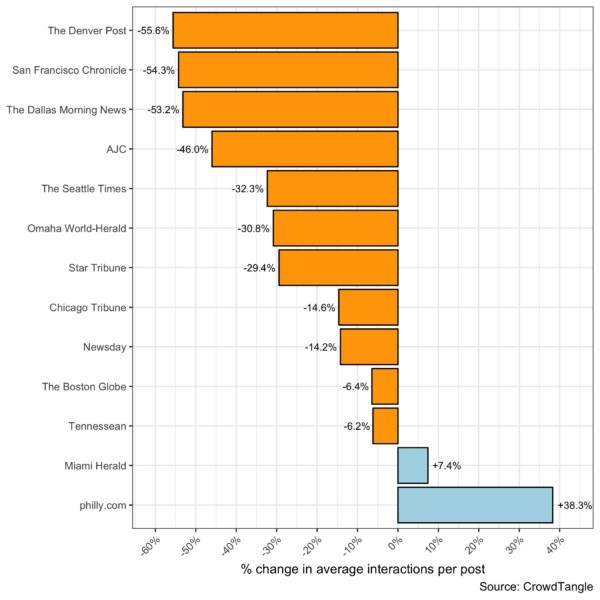
Chart 11: Change in average interactions with Facebook posts before and after the pro-local news algorithm change (January 1, 2016–January 28, 2018, versus January 29, 2018–April 1, 2018).
Inability to Monetize On-Platform
When we asked publishers in our interviews about monetization on platforms, the answers we heard varied significantly. Some said monetization on YouTube is good. Others said it’s awful. Some said Apple is reliable for making money and others said it’s nonexistent within their revenue strategy. One publisher called Snapchat a “suboptimal monetization platform” and another said it’s “just horrible,” while a third said it’s become a worthwhile partnership. While most publishers whom we spoke to were happy with Twitter, one publisher called it “a garbage fire.”
What is becoming clear is that attempting to translate the advertising-driven business model of news publishing from print to digital by posting high volumes of content to social platforms and adopting platform-native products has not been lucrative for publishers.
Failed products
The data for financial success around Facebook-specific products, especially, tell a story of limited outcome. Take, for example, Instant Articles. As Pete Brown wrote for CJR in February 2018:
“When launching the product in May 2015, Facebook presented its new initiative as a commitment to helping publishers monetize journalism distributed via its platform. Instant Articles, it was claimed, would solve the problem of sluggish mobile websites. While publishers would have to host their articles on Facebook’s servers and post natively to the platform, they would supposedly reap rewards—in terms of scale, engagement, and revenue—from being able to serve mobile content that loaded at lightning speeds via Facebook’s app.”
Michael Reckhow, then-product manager for Instant Articles, introduced the product this way: “We designed Instant Articles to give publishers control over their stories, brand experience, and monetization opportunities. Publishers can sell ads in their articles and keep the revenue, or they can choose to use Facebook’s Audience Network to monetize unsold inventory. Publishers will also have the ability to track data and traffic through comScore and other analytics tools.”
When Instant Articles launched, many high-profile publishers jumped at the opportunity to try it. In September 2015, The Washington Post announced it would “send 100% of its stories to Facebook so that all Washington Post content can be formatted as Instant Articles, giving readers a lightning-fast user experience for reading, sharing and commenting within the Facebook iOS app.”
But a little more than two years later, in early 2018, over half of Facebook’s launch partners for Instant Articles were not using the format. Of 72 publishers that Facebook identified as original partners in May and October 2015, our analysis of 2,308 links posted to their Facebook pages on January 17, 2018, found that 38 publications did not post a single Instant Article.
Abandonment of Instant Articles
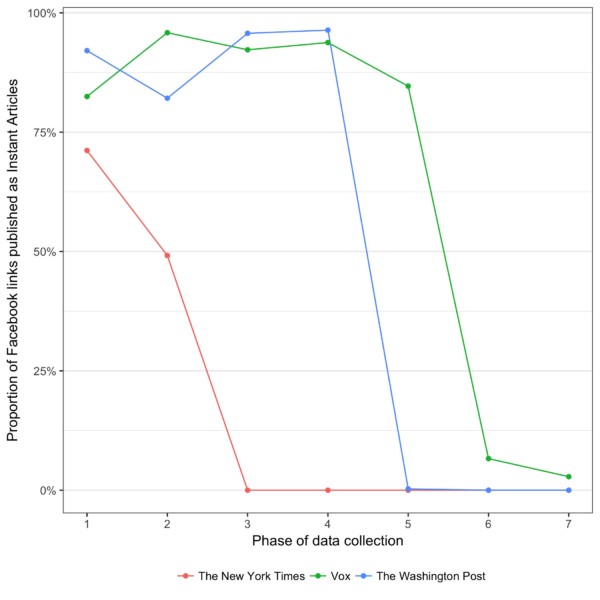
Chart 12: The proportion of Facebook links published as Instant Articles by three news outlets that have now abandoned the product (August 2016–March 2018).
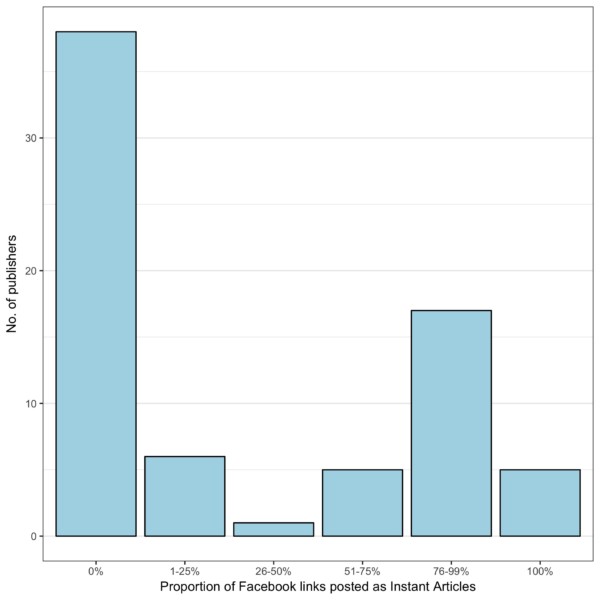
Chart 13: Use of Instant Articles by 72 early partner news outlets, as of January 17, 2018.
The decision to shun Instant Articles means that considerably more links direct traffic back to publishers’ websites than remain native to Facebook. Of the 2,308 links analyzed, 1,491 (around two-thirds) went to a publisher’s homepage, leaving 817 as Instant Articles.
For CJR, Brown concluded: “Instant Articles has been criticized for underwhelming monetization, limited user data, and underwhelming options for subscription-based outlets.” Even so, he noted that it’s difficult to argue that Instant Articles is an altogether failing product when Facebook can still point to growth and huge usage numbers. “Last June, the company boasted that it had ‘10,000 publishers around the world using Instant Articles, growing over 25 percent in the last six months alone.’ But, with the high-profile publishers moving out of Instant, is this another example of Facebook prioritizing quantity over quality?” Brown asked.
In another case, our data shows that publishers seemed to have also abandoned Facebook Live once financial incentives from Facebook to use it expired. According to The Wall Street Journal, Facebook reportedly began paying select publishers and personalities in March 2016 to produce Live videos for its platform. A select few included BuzzFeed, The New York Times, CNN, HuffPost, and Vox Media. (The Wall Street Journal estimated that these top outlets each received anywhere between 1.2 and 3.1 million dollars in compensation.) At the time, Facebook also calibrated its News Feed to prioritize Live videos over other types of content.
As Brown published on CJR in February 2018, “A year later, Live swiftly fell out of favor and ‘longer, premium video content’ became the new priority. Watch, the platform’s video on demand service, has become Facebook’s video product du jour.”
As such, the number of Facebook Live videos produced by paid partners more than halved by the end of 2017 our data suggests—and in one case fell by as much as 94 percent—once guaranteed payments ended and Facebook de-prioritized the product.
Abandonment of Facebook Live Once Financial Incentives Ended
Our data analysis shows that of the 17 brands paid by Facebook to make live videos for the platform, the number published from April to December 2017 fell by an average of 51 percent when compared to the 12-month period from April 2016 to March 2017.
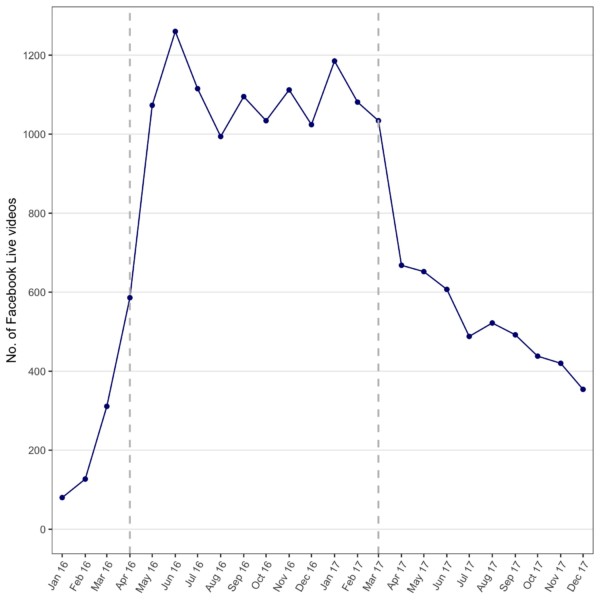
Chart 14: The number of Facebook Live videos posted by 17 paid brands during 2016 and 2017 (n=17,752).
Even with minimum guarantees in place, the terms around payment could change suddenly. As one large publisher detailed to us in an interview, in their case (publishers negotiated specific terms), first they received a monthly fee if they produced a set number of Live videos. The platform was, as this publisher put it, “paying to fill the pipes.” But when Facebook decided to focus on mid-roll ads placed against longer videos (meaning advertisement breaks that occur in the midst of viewing), the arrangement changed to mean that the publisher earned ad revenue only when it exceeded the monthly guarantee from Facebook—which did happen. So when the monthly guarantees stopped, the publisher assumed they’d continue to earn at similar rates even against mid-roll ads alone. Instead, they saw a dramatic decline in revenue they said they were not prepared for.
Still, no decrease in volume of content posted
Yet for all the turmoil and uncertainty in publishers’ relationships with tech platforms, those in our study have continued to populate third-party platforms with substantial amounts of content.
Volume of Content Posted
Following an unsurprising spike during the week of the US election (week beginning November 7, 2016), when a combined total of almost 25,000 items were posted, the number of posts pumped out to platforms remained remarkably consistent. The 12 publishers in our study typically posted a combined total of about 22,000 items per week—an average of 1,800 each—during each phase of data collection.
The consistency and sheer volume of content being posted to platforms highlights these publishers’ ongoing commitment to meeting their audience where it is—even though it’s on somebody else’s turf.
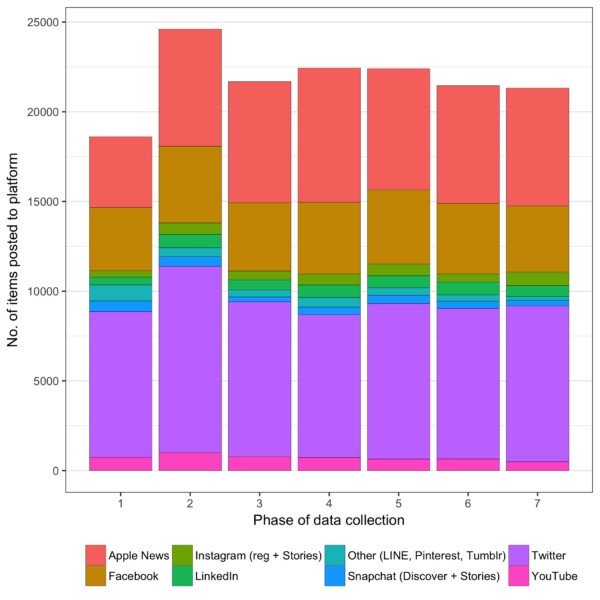
Chart 15: Aggregated number of posts recorded during each phase of data collection, separated by platform (August 2016–March 2018).
To evaluate how much content was published to each platform over our analysis, the 14 platforms in our study are best understood if they are broken down into three categories:
- High volume: Apple News, Facebook, and Twitter
- Medium volume: Instagram, Instagram Stories, LinkedIn, Pinterest, Snapchat Discover, Snapchat Stories, and YouTube
- Lower volume: li.st (formerly The List App, now defunct), LINE, Messenger, and Tumblr
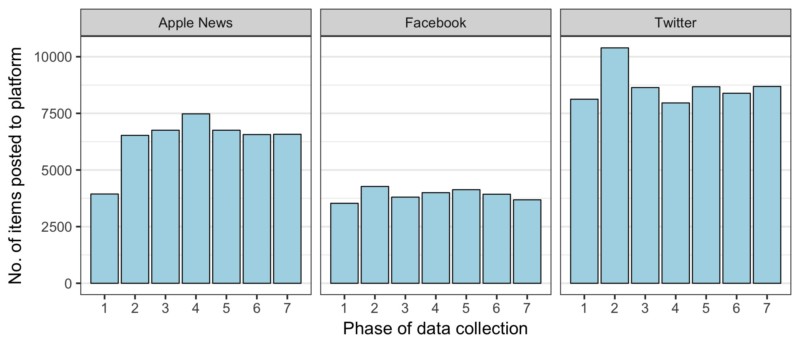
Chart 16a: Total number of posts made to high-volume platforms during each phase of data collection (August 2016–March 2018).
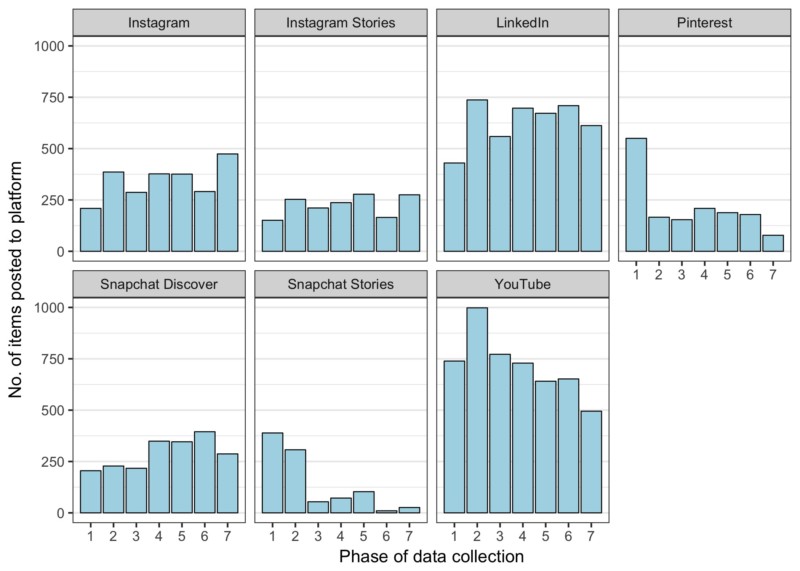
Chart 16b: Total number of posts made to medium-volume platforms during each phase of data collection (August 2016–March 2018).
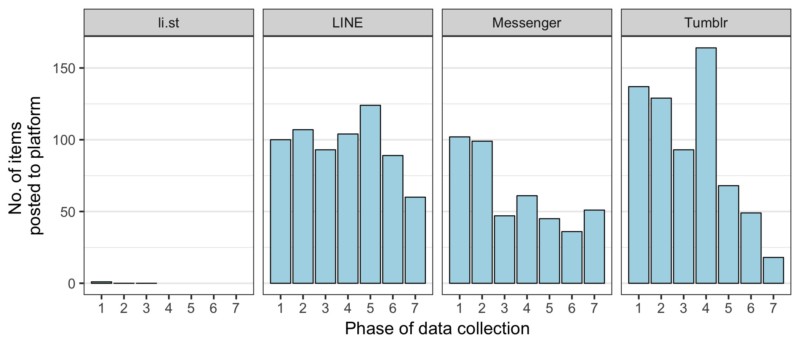
Chart 16c: Total number of posts made to lower-volume platforms during each phase of data collection (August 2016–March 2018).
A retreat from platform-native content
However, accessing the volume of content posted to platforms in isolation only tells part of the story. Our data also demonstrates how publishers attempted to wrestle back a degree of control from platforms by both reducing the amount of “free” content “given away” in the form of platform-native content and increasing the proportion of content placed behind platform-provided paywalls.
Networked versus Native Content by Publisher
In our study we differentiated between three types of content:
- Networked—Posts made to platforms whose primary purpose is to drive audiences back to a publisher’s website (e.g., Twitter, Pinterest, LinkedIn, and Facebook links that are not Instant Articles).
- Native—Posts that were hosted natively on third-party platforms and could be viewed for free without a subscription (e.g., Instagram, Facebook Instant Articles, native Facebook videos, paywall-free Apple News channels, and Snapchat). This is content that publishers are sometimes said to have “given away” to platforms.
- Native paywalled—Posts made to third-party platforms that could only be viewed with a subscription (e.g., paywalled channels on Apple News).
The proportion of the content “given away” in the form of platform-native posts reached its lowest point in the March 2018 analysis, when it was recorded at 30 percent—down 25 percent from the level observed in August 2016.
Broadly speaking, as of the final phase of analysis, 70 percent of content was either (a) intended to drive traffic back to publishers’ websites or (b) required readers to pay to view paywalled content on a third-party platform.
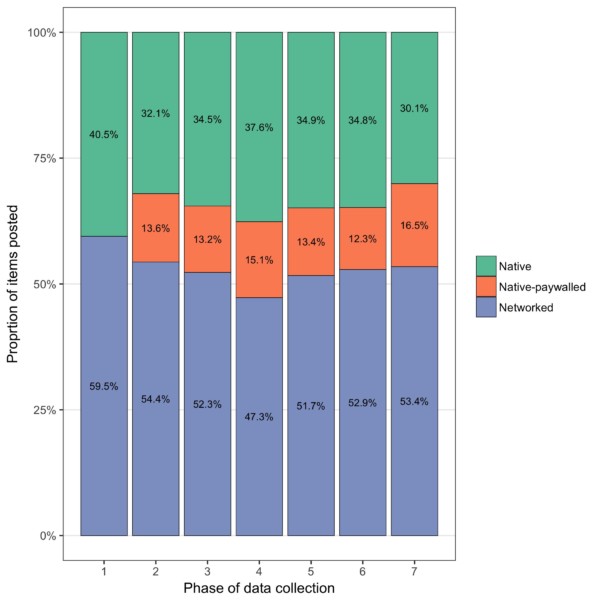
Chart 17: The overall proportion of native, networked, and native-paywalled posts during each phase of data collection (August 2016–March 2018).
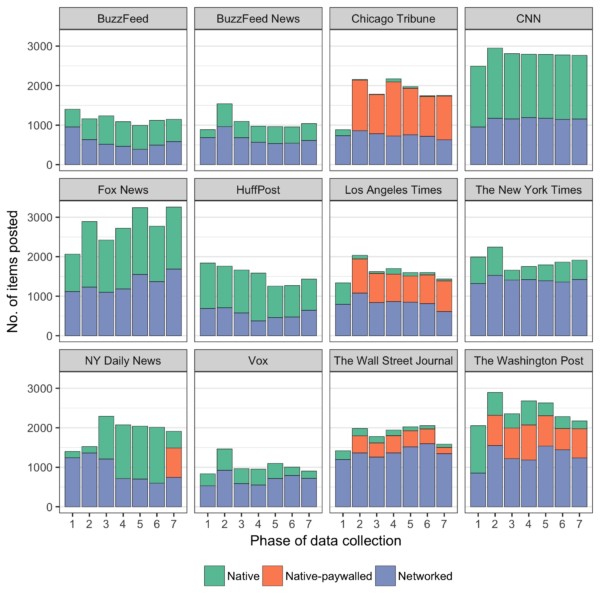
Chart 18: A breakdown of native, networked, and native-paywalled posts by each publisher during each phase of data collection (August 2016–March 2018).
Zooming in on the proportion of native (“free”/un-paywalled) content “given away” to platforms (Chart 19), a range of approaches come into focus.
- CNN’s approach to native content remained remarkably steady, settling on a strategy of posting around 60 percent of content in platform-native form. Similarly, HuffPost, a digital native, consistently made over half of its posts available in platform-native form.
- At the other end of the scale, the Chicago Tribune and Los Angeles Times remained steadfast in their refusal to give much away as native content, particularly once Apple News introduced its paywall. Another of the subscription-based outlets, The Wall Street Journal, frequently posted to a wide range of platforms, but typically made less than 10 percent of posts available in free, platform-native form.
- The New York Times flip-flopped to some extent, initially curbing its use of products such as Facebook Instant Articles and Facebook Live, but later embracing other native platform products such as Snapchat Discover, Instagram Stories, and increasing the number of articles posted to Apple News.
- Vox reeled-in the amount of platform-native content it posted by around half (largely due to its abandonment of Facebook Instant Articles). But by far the biggest change of heart came from The Washington Post. In the earliest analysis, The Post was not only posting vast quantities to Apple News (which at that point did not have any paywall facilities), it was also “all in” on Facebook (The Post’s evolving approach to Facebook is discussed below and shown in Chart 22). Consequently, the proportion of platform-native posts by The Post clocked in at just under 60 percent. Even as The Post embraced native platforms such as Instagram, Instagram Stories, and Snapchat Discover, it put its Apple News channel behind the post-iOS 10 paywall and scaled back its use of native Facebook products such as Live, Instant Articles, and videos. By the final analysis, the proportion of native content pushed out by The Post had fallen below 10 percent.
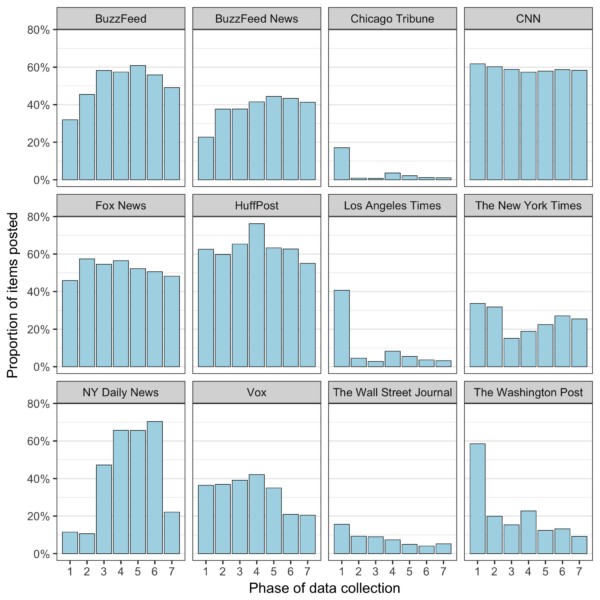
Chart 19: The proportion of posts “given away” to third-party platforms in the form of native (free/un-paywalled) content.
Unlike most platforms, which are typically either primarily native (i.e., publishers’ posts are hosted and consumed on the platform, e.g., Instagram) or primarily networked (i.e., posts are intended to drive traffic to the publisher’s website, e.g., Twitter, LINE), Facebook has a degree of flexibility.
Facebook Videos, Live videos, photos, etc., are always native to Facebook. However, publishers have a choice when it comes to their articles—they can either post a link that directs the Facebook user to a post on their own website (networked), or upload the content of the article in Facebook’s proprietary format, known as an Instant Article, which is hosted and consumed on Facebook (native).
The chart below shows the proportion of each publisher’s Facebook posts that were designed to live natively on Facebook (Instant Articles, videos, Live, etc.).
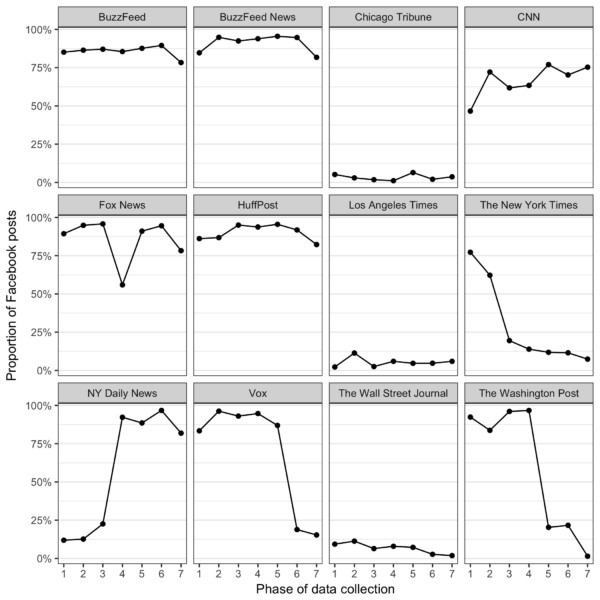
Chart 20: The proportion of each publisher’s Facebook posts that remained native to the platform during each phase of data collection (e.g. native video, Instant Articles, Facebook Live, etc.) (August 2016–March 2018).
Three of the publishers in our study stand out for their retreat from Facebook native—The New York Times, Vox, and The Washington Post. All initially made a majority of their Facebook posts native (albeit to varying degrees). Vox and The Washington Post, in particular, were very much “all in” on Facebook—it was not uncommon for these two publishers to make 90–95 percent of their Facebook posts native to the platform. The proportion of Facebook-native posts made by The Times peaked at 77 percent.
But the three publishers eventually did an about-turn in their approach to Facebook-native content. The New York Times was the first to go cold on Facebook—the proportion of Facebook-native posts had fallen to 19 percent by February 2017. Next was The Washington Post, whose native posts fell from 97 percent in May 2017 to 20 percent in August. Finally, Vox’s plummeted from 87 percent in August 2017 to 19 percent in November 2017. In each case, the proportion of native content reached an all-time low for the publisher by the time of our final analysis in March 2018.
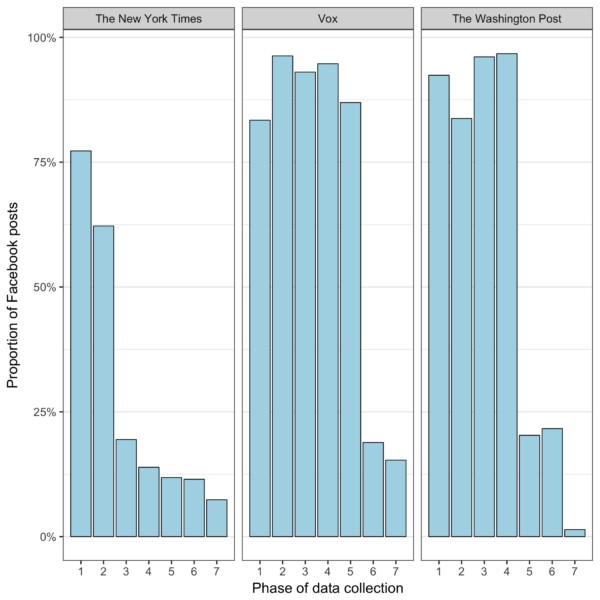
Chart 21: The retreat from native Facebook posts by The New York Times, Vox, and The Washington Post (August 2016–March 2018).
The Washington Post’s change of heart around Facebook-native content is particularly striking and can be traced over time (see Chart 22). During our first analysis, in August 2016, native Facebook content dwarfed networked links back to The Post’s website. This approach continued through the May 2017 analysis, when 97 percent of content posted to Facebook by The Post was designed to be consumed natively on-platform.
However, the tide had turned by August 2017 when, having abandoned Instant Articles, the proportion of Facebook-native posts fell to 22 percent—this native content being made up of 85 videos and eight Live videos. Fast-forward another seven months and all but four of The Post’s 282 Facebook posts were networked links. This meant that just one percent of its Facebook posts for the week were designed to live on Facebook—the remaining 99 percent were intended to drive Facebook users back to The Post’s own websites. In other words, by this point Facebook had become little more than an RSS-style link factory for the publication.
When The Washington Post first partnered with Facebook on its then-nascent Instant Articles in September 2015, a blog from its PR team announced: “The Post will send 100% of its stories to Facebook so that all Washington Post content can be formatted as Instant Articles, giving readers a lightning-fast user experience for reading, sharing and commenting within the Facebook iOS app.” The same announcement quoted Washington Post publisher Fred Ryan saying, “We want to reach current and future readers on all platforms, and we aren’t holding anything back.” Two and a half years later, The Post was holding almost everything back.
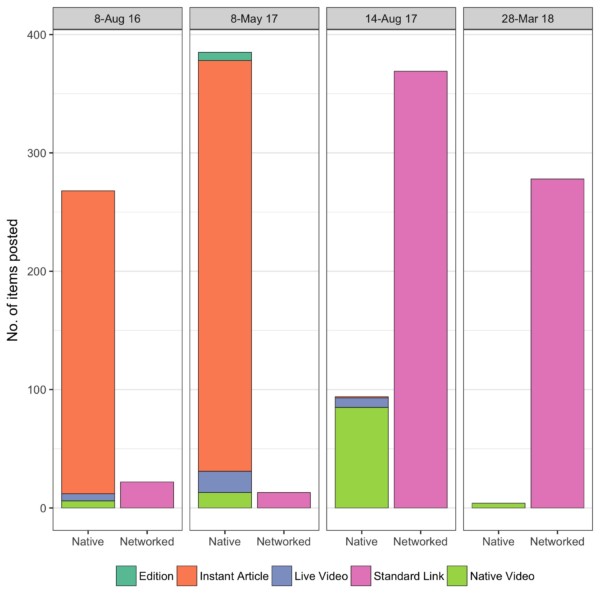
Chart 22: The Washington Post’s retreat from almost all forms of native Facebook content.
Diversifying Publisher Strategies
The inseparability of social and search platforms from digital publishing in terms of audience reach and monetization means that the platform-publisher relationship is now a permanent feature of the news ecosystem. Today, it is clear that few news monetization strategies will be complete without platforms. However, the questions are which platforms, how to work with them, and why.
Since our research began, publishers now have a clearer view of what platform product offerings do and don’t include, what each platform’s priorities are, and how they move and change over time. So while long-term platform strategies remain difficult to craft, publishers are beginning to approach monetization more intelligently with the benefit of hindsight. They currently see the key to survival as diversifying revenue streams both on and off social platforms
News outlets better grasp that platforms’ objectives will not always align with their own, and that platforms’ business needs will come first. Even a digital-native publisher that enthusiastically embraced platforms in our initial interviews described the relationship as a one-way street, and the past couple of years as “sobering.”
“I’m a very excitable person when it comes to new ways to tell stories and engage audiences on platforms. That’s what gets me out of bed,” the publisher said. But now, “everybody I know who does the kind of job I do also gets out of bed in the morning thinking, ‘You know, this doesn’t feel as fun as it used to.’”
One legacy publisher told us their relationship with platforms feels like the same conversation over and over, “just with a lot more examples and a little bit more scar tissue.”
Notable shifts in thinking and approach
Overall, publishers have come a long way since the early months of 2016, when many of them were grappling with what was then a new, distributed reality. One publisher told us in 2016 that their fear centered around the tenet, “Don’t build your house on someone else’s land.” Another said, “One of the things that makes this so scary is that publishers don’t know what [control] they can retain.” This angst, it seems, has given way to an understanding that financial sustainability likely means that parts of their business will have to be built in a partnership with platforms—though not without a more measured approach.
There emerged some common themes among publishers asked about how their on-platform monetization strategies have changed since our initial interviews:
- One key change we heard is that as pursuing ad revenue at scale proved inadequate for sustainability, publishers have shifted focus from the pursuit of large audiences to the pursuit of monetizable ones. In an early interview, one publisher told us: “The general mindset these days, and it’s growing, is: do you want to be in front of as many eyeballs as possible?” But in a more recent interview, another publisher highlighted an adjustment to this, saying it’s now become apparent that “ultimately, an engaged audience is valuable and monetizable.”
- Publishers have also evolved from wanting to be “all in” on every platform—and feeling seduced by inclusion in certain platform product rollouts—to being more vocal and proactive about their needs. They have begun to ask: does this product work for my business? One publisher said, “About a year and a half ago we decided that we needed to put more strategic thought around how we engage with our platform partners. We were being pretty reactive to the opportunities they are bringing to us and … didn’t quite know how to think about the alignment with our business.”Another publisher reflected recently:
“At that time, there was a lot of pressure on publishers to work with everyone at once. For all the biggest publishers, that’s a difficult situation to be in—to have the opportunity to work with these groups who bring such fantastic audiences, that’s a great thing. But to execute on that potential and often make choices about resources, that means pulling developers away from one project to work on another. With every exposure of opportunities in the industry comes an explosion of choices that product managers and others need to make about where we spend our time coding, developing, and designing. I think we are past that now. There’s been some shakeout in that space. Things have slowed down a bit. Everyone’s looking more internally than they were before. The secret to success is not always outside. It’s interesting to see publishers now looking for more of a balance. Working with third-party platforms is an important part of our business, but it’s not the only part of the business. You need to know why you’re making these decisions and what you’re not doing when you’re working with different players out there. … There are a few publishers out there who can afford to work with all of them at once. But for a lot of us, we’ve had to make choices.”
- Publishers more clearly understand that opportunities are constantly changing, and they need to adapt to the new pace. One told us, “Whatever works today is probably not going to work in six months,” and another said, “It’s like we are all portfolio managers, operating with the notion of investing in where the return is the greatest in that particular time.”
- And, finally, publishers have more clarity around “total value” from platform strategies, and a greater appreciation for non-monetary forms of ROI like brand awareness and audience access. As one publisher put it:
“When we look at the total value, we don’t ascribe that solely to something we can reconcile with dollar figures. We’re trying to accomplish a number of different things. Of course we’re looking to make money. Of course we’re looking to reach new audiences. Of course we’re also looking to deeply engage highly passionate communities and build up folks who are deeply loyal to our brands. We’re also really interested in doing new, interesting, bold things.”
Responsiveness to audience
One particularly positive outgrowth of the platform-publisher relationship is, as one publisher said, it has “made us more responsive to our audiences, period.” Another told us, “We are now more accountable to the people we’re talking to. It democratizes journalism that much more.”
In the pursuit of reader revenue, publishers are recognizing a misstep: individual readers were seen only as numbers, and the goal was infinite scale. One publisher said:
“News organizations lost the idea of the audience as a real user, somebody that you had to work to acquire. Now there is this turn to understanding that our mission needs to be stronger. We need to be more respectful of our audience, because we need to have a direct relationship with them. They are not just a couple of billions that show up in analytics, but real people who care about news or who want a reliable and trustworthy news experience.”
Publishers especially expressed regret about tactics they’ve used in the past to generate large audiences and short-lived social velocity, such as reaction baiting. As the meaning of engagement changes, publishers are now seeking to build loyalty with an eye toward reader revenue and subscriptions, rather than (or in addition to) tweaking content to optimize readers’ likes and shares.
“We were just asking people to respond to a political statement with a smiley face or a laughing face or frowny face. How were we actually contributing to the conversation? How were we informing, how were we educating, how were we contributing?” a publisher said, adding: “You might have a ton of reactions and a ton of shares [on a post], but you don’t have any comments, and the comments you do have are just people fighting.” The question then becomes: “Are you ‘winning’ in social media, but really losing the journalism battle here by posting something like that?”
That being said, publishers are appreciative of the visibility and voice audiences have on platforms. One publisher noted, “The audience now has much more influence in what we’re doing, either by where they choose to consume us, or how they choose to consume and how they choose to interact with us in public. It highlights the responsibility that we have to them in a different way than it has in the past.”
But even as platforms have brought publishers closer to their audience in some ways, a major problem still exists: publishers can only get their hands on those insights and analytics that platforms are willing to part with. And on each platform, the behaviors chosen to measure are different. Therefore, as one publisher put it, it can still at times feel like the audience is behind a window. “You can’t necessarily hear what they’re saying to you. You just know that they’re there. It makes it much harder to anticipate their behaviors—to anticipate what they will do with the content.”
Despite these challenges and frustrations, according to the survey we conducted, half of the respondents said “social media platforms such as Facebook have strengthened [their] newsroom’s relationship to its audience,” with only one in five (22 percent) saying the relationship weakened.
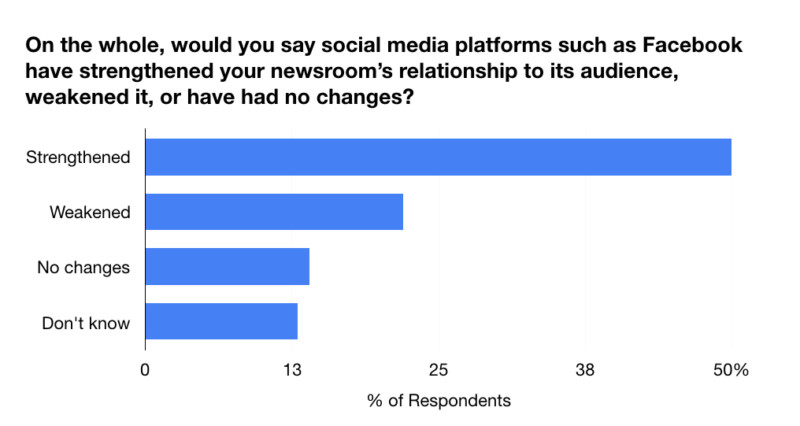
Shift to reader revenue and subscriptions
Publishers are aggressively seeking alternatives to advertising to ever-growing numbers of people—namely in the form of reader revenue, involving events, paid subscriptions for prestige publishers with healthy audiences who can paywall their content, and membership and donation revenue for publishers who want to keep their content open.
In line with this, paywalls are going up across the industry in rapid succession; days apart in April 2018, Bloomberg and Vanity Fair announced new paywalls. “I think 10 years ago every newsroom in America would have said, ‘It’s not my job to get people to subscribe,’” said one publisher. “And now everyone’s fighting for their lives—so, they feel like it is.”
Even so, platforms still remain very much a part of this picture. iPhone users have been able to subscribe to individual publications in the Apple News app since late 2016, with Apple taking a 30-percent cut of new subscription revenue and 15 percent of renewals. Since April 2017, Amazon has a similar news offering under the program Subscribe with Amazon.
A few months into 2018, Google and Facebook have begun to roll out subscription products that have been under development since last year. Subscribe with Google will allow users to subscribe to a publication using their Google account with only a couple of clicks, and will also prioritize those publications in a user’s search results. Facebook’s subscription tool, which is currently being tested with 13 publishers including The Washington Post and Los Angeles Times, will allow publishers using Instant Articles to put up a paywall after a user accesses a certain number.
Apple has also announced a multi-subscription service in the works. In March 2018, the company acquired the magazine-subscription app Texture, which allows users to pay a monthly subscription for access to multiple magazines. Apple plans to integrate this technology into its current news product, Apple News, and publishers will receive a portion of the service’s revenue.
In the meantime, many publishers pursuing reader revenue must continue to rely on platforms for ad revenue until subscription dollars catch up. One local publisher described the current strategy as “driving pageviews essentially to keep the ship afloat while we figure out how to really drive subscription revenue.” Another asked, “How do we balance the needs of a subscriber base that’s deeply engaged with the need for scale?”
As report author Elizabeth Hansen and Emily Goligoski wrote in their Tow Center report “Guide to Audience Revenue and Engagement” in February 2018: “Rarely are news organizations 100 percent funded by direct audience revenue alone. Digitally native publications are relying on a mix of revenue approaches—including advertising, corporate underwriting, foundation funding, article syndication, events, affiliate programs, merchandise, and book sales—in addition to or instead of direct revenue from audiences.”
Reader revenue will likely prove to be just as nuanced and platform-involved as the search for digital advertising has been. While donation and membership models don’t typically rely on social or search platforms for converting readers into paying supporters, platforms are an integral part of the audience building and audience engagement which must precede requests for financial support.
Brand
Many subscription-supported publishers will still need the platforms to reach new audiences. The undeniable fact is that platforms channel the majority of internet traffic overall, and just two platforms (Google and Facebook) refer the overwhelming bulk of that traffic to publishers.
In early interviews, brand recognition was a major concern. Those concerns have lessened over time as publishers understand that platforms are actually the top way to relay brand to audiences. “My belief continues to be that if you want to build a big brand that has currency with the audience, you have to be as aggressive as possible at building it out on platforms,” one publisher said. “It is the single best way to market your brand and your content. If you don’t do that, you will not be able to monetize on your owned and operated properties, no matter how good your model is, now matter how good the content.”
Another said, “It would be highly imprudent for businesses to think that they can build subscription businesses without any regard for platform partners,” adding, “I think we are moving to a place where platforms become, essentially, marketing platforms that allow for the audience to brush up against the brand. Then [publishers] need to figure out how to get them and keep them.”
One publisher mapped out an ideal future this way:
“If you can get to a place where you’ve got a large enough subscriber base and an efficient enough programmatic team, and a pretty decent brand studio that you can run a business without really having to care very much about generating huge audiences on these other platforms, that’s fantastic. But nobody has that yet. We have a shot at it, I would say. We might get there in two to three years. It’s going to be a perilous road, but it’s possible.
At that point, that’s a business where you can kind of give the finger to the platforms. Until then, the platforms are how you keep your brand relevant. It’s how you drive traffic back to your site, which leads to familiarity and eventually conversion and retention of subscribers.
We’ve got a ways to go, but the hope is that one day we’ve got a business that looks something like that of Netflix—where we’ve got a lot of really strong direct paying relationships with customers and we’re far less reliant on the crazy whims of the big platforms from a business perspective. Platforms will always have a lot to do with customer acquisition and audience development, but they won’t be as essential to our business model as they are right now.”
The Platform Response
As publishers become more discerning around the platform products they choose to adopt and use, especially after having spent a number of years experimenting with non-lucrative opportunities, platforms are responding with new initiatives (among them subscription services) to keep publishers inside the partnership fold. In many cases, this means a race to differentiate themselves.
Rising platform competition
Especially in the wake of post-election “fake news” and user privacy concerns, platforms are focused on distancing themselves from Facebook, which is as formidable among its competitors as it is among publishers. During our interviews, one platform executive said of publishers in reference to Facebook: “They cannot rely on that platform, there are too many changes.” Another took aim at one of Facebook’s main product offerings, dismissively describing Instant Articles as “basically a way for publishers to get their content into Facebook in a very first-class way for Facebook.” Yet another platform executive insisted, “All platforms are not the same. And we’re not a social platform, which is a key difference. We’re not focused on virality and click bait and that kind of stuff, which is really important and good for publishers.”
This interview data is backed by public actions some platforms took to reassure their publisher partners after the January 2018 Facebook News Feed algorithm change. Days after the algorithm change, Snapchat sent an email to publishers to announce the newly created company role of media partnerships manager.
Flipboard more directly sent an email with the subject line “Flipboard is here for you” that read: “Publishers large and small are discussing the implications of the recently announced changes to Facebook’s News Feed. We thought we’d take this opportunity to underscore our commitment to the industry and to you.”
These overtures are not, however, always taken at face value. One publisher dismissed the recent uptick in platforms’ publisher outreach as just “other platforms that want to compete in the wake of Facebook pissing everybody off.”
This growing differentiation is particularly evident among Google’s efforts. One publisher described the shift in this way: “In the past, Facebook was very concerned about being lumped in with Google, in terms of their willingness to work with publishers, their willingness to work on paywalls, and their challenges around antitrust. Yet, the tables have completely turned. Google is now very concerned about being lumped in with Facebook. There’s a bit of a wooing going on, and it’s quite interesting.”
In the current environment, platforms are putting tremendous effort into identifying and articulating their distinct value to publishers. One platform executive said that instead of disintermediating publishers from their users, their company is “trying to create a system to help users find content—and find where it came from—and explore that relationship.”
Another platform executive said that while their product’s audience and revenue may be small compared to Facebook’s, they have “a natural lean-in audience for news” and are “seeking to create a sustainable, mutually beneficial model.” While platforms say they are making adjustments to accommodate publishers, some reiterated that news efforts are user-first.
One platform expressed feeling prompted to get “people to come in and start to look at the content that’s around them and engage more deeply” via their news product after noticing a “swell in organic interest and people reading and engaging with news content, separate from any one thing, source, or region.”
Still, emerging platform competition is starting to give publishers leverage. As platforms continue to evolve their offerings for publishers, in some cases “copying” from their competition, news outlets are sensing that they can afford to be more selective. They have more choices and can, for example, choose Instagram Stories over the product it is essentially a copy of, Snapchat Stories.
Snapchat versus Instagram
A major trend over the last 18 months has been the rise of platform products replicating Snapchat Stories, and publishers picking “platform winners.” Instagram launched its clone in August 2016. Facebook’s came in March 2017, and Google launched AMP Stories in February 2018.
In June 2016—back when Snapchat Stories was the only product of its kind on the market—we observed a surge in individual “snap stories” posted on Snapchat by newsrooms not included on the Discover channel. Publishers that didn’t manage to gain a coveted slot on the Discover news page were nevertheless producing lots of stories for Snapchat’s prime audience of mostly under-25-year-olds.
All of the publishers in our sample have accounts on Snapchat Stories—and, initially at least, a majority were making active use of them. During the three weeklong analyses we conducted in 2016 (including the smaller pilot in April 2016), multiple publishers were routinely posting a combined 300–400 snaps to Snapchat Stories. Even after Instagram cloned Snapchat’s Stories feature in August 2016, Snapchat retained the edge over its new rival through the remainder of that year.
However, that all changed in 2017. Each time we did an analysis during 2017, our publishers were using Instagram Stories far more prolifically than Snapchat. In a November 2017 study, just 10 snaps were posted to Snapchat. Twenty times that number were posted to Instagram Stories.
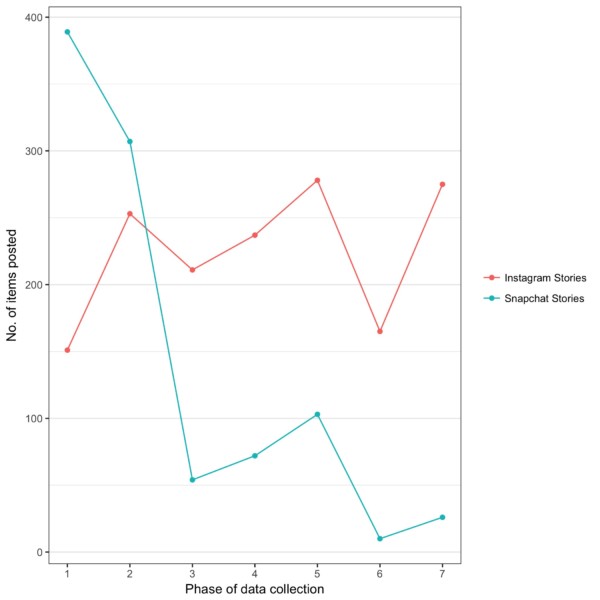
Chart 23: The number of “snaps” posted to Snapchat Stories and Instagram Stories by 12 publishers over seven weeklong periods (April 2016–March 2018).
This transition from Snapchat over to Instagram comes into even sharper focus when comparing the number of publishers using each platform. Since February 2017, the highest number of publishers we saw posting to Snapchat Stories was three—in November 2017, it fell to one. During the same period, the number of publishers using Instagram Stories routinely ranged from eight to 10.
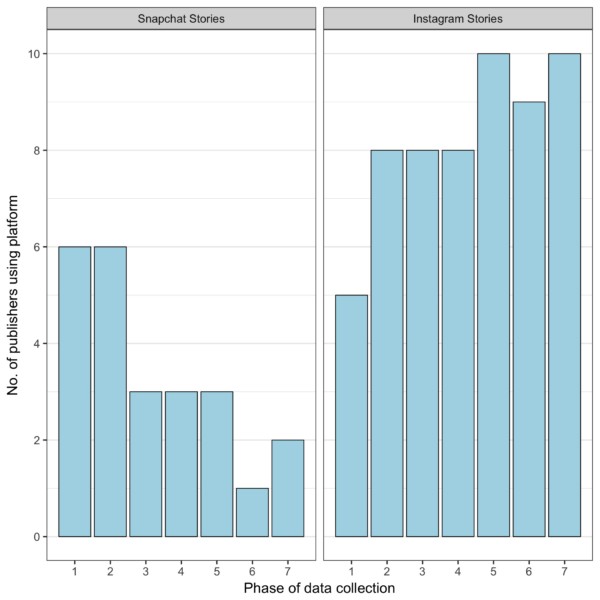
Chart 24: The number of publishers out of the 12 observed that used Snapchat Stories and Instagram Stories during seven weeklong periods (April 2016–March 2018).
New platform incentives for publishers
As publishers have become less willing to devote resources toward products with uncertain futures, financial incentives from platforms are on the rise. One publisher participating in a Google product beta said they were “financially incentivized” to work with Google, and compared it to a “subsidy,” saying, “They came to us upfront, like, ‘We want you to be a part of this. … So you tell us what you need to actually produce it and then we’ll pay you for that.’” Facebook has likewise offered publishers substantial advertising credits on its platform to participate in product rollouts.
Tech platforms are now the most well-resourced media companies in the digital space. In late 2017, news broke that both Apple and Facebook had one-billion-dollar budgets for original programming, with Facebook reportedly offering three to four million dollars per episode of new programming and Google-owned YouTube offering two to three million dollars for the same. In March 2018, Facebook announced it was adding a section of Watch specifically for news shows. So far discussion of those budgets are smaller, with the platform offering publishers up to 10 million dollars per year for original daily programming (each episode is short, under 15 minutes). One publisher we interviewed, who was offered closer to eight million dollars, called the amount “laughable.”
Among the most well-resourced publishers we interviewed, though, there was a notable turn toward discussion of creating bespoke video content for platforms. One publisher said of the industry response to these new budgets: “We’ve gotten a number of emails and calls from friends in other companies saying, ‘Hey, what did you guys pitch Facebook? How long were the shows? How many did you pitch and how much were they willing to pay?’ Any time anybody enters the market with money, everybody’s going to turn in that direction.”
Another said, “Now [platforms] are buying shows—actually just full on buying the IP and doing much more Netflix-style deals. Literally they’ve hired someone from Netflix to crank out these deals. They’re treating publishers like production companies.”
In some cases, these publishers are not necessarily producing this new content with their own or existing audiences in mind. One publisher creating a show for Twitter said, “We are designing, programming, and producing it for a Twitter audience, rather than for [our] audience. Those two audiences are very different, and we don’t want to look at them as being particularly duplicative or overlapping.”
Overall, the financial incentives platforms are offering to publishers focus on funding endeavors that keep users’ attentions on the products created by individual platforms as opposed to journalism itself. It’s worthwhile to remember that for platforms news is but a small piece of a much larger picture, or, to quote Mark Zuckerberg, “‘a pretty small minority’ of what people are reading on Facebook.” And, while over half (56 percent) of the respondents to our survey said social media platforms should take “a great deal” or “quite a bit” of responsibility for financially supporting quality journalism, with only one in five (or 22 percent) saying they had “a little” responsibility or “none at all,” Zuckerberg has said: “I’m not sure that makes sense.”
The question of platform neutrality
Another issue at stake as platforms are increasingly willing to involve themselves with more functions of traditional news publishers—from funding, to commissioning content, to creating publishing formats, to exercising curatorial judgement, to matching audiences and advertisers—is their struggle to claim and maintain platform neutrality. To avoid the legal responsibilities that being a publisher entails, Facebook and other social platforms have long sought safe harbor under Section 230 of the Communications Decency Act, and have held firm that it is their legal right to be shielded from liability for the content their users post to their platforms.
But as of April 2016, Twitter was listed as a “News” app on Apple’s App Store; previously it was labeled as a “Social Networking” app. Facebook and Google continue to roll out “news” and “journalism” initiatives. And in May 2017, Apple hired its first editor in chief to oversee other editors curating content alongside the algorithm in an Apple newsroom. Apple’s choice is in stark contrast to Facebook’s decision in mid-2016 to fire all human Trending news curators after allegations of bias.
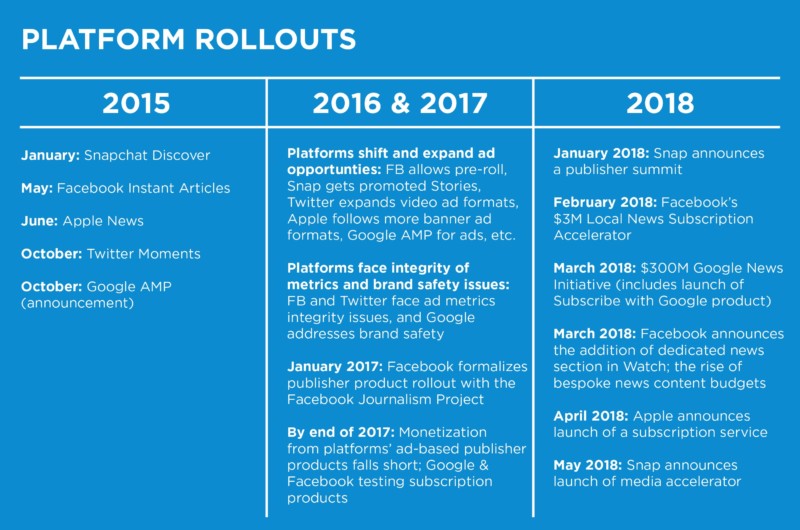
Still, in our interviews, platforms used careful language to describe their roles around news content. One platform said they emphasize “relevant” and “trustworthy, high-quality sources”; when asked about the inherent editorial judgement required for such a curation strategy, they told us that curating news is no different than curating other types of media, adding: “It’s way more about hiring people, editors and journalists from the field, who have a good sense of editorial judgment.”
Another platform said, “We definitely have a lot of newsrooms and video companies utilizing the platform. So when it comes to news I think we’re kind of central to the news industry” but, “we would firmly say we’re not a newsroom organization. We don’t create any content. We curate content and, you know, that’s a bit of an editorial role.”
Yet, when news broke that data from more than 80 million Facebook users could have been improperly obtained by the political consulting company Cambridge Analytica and wielded to target users with content to sway their votes in the 2016 presidential election, likely in favor of Donald Trump, Mark Zuckerberg’s congressional hearing became a forum through which lawmakers openly grappled with platforms’ influence and power. Senator Dan Sullivan’s line of questioning about whether Facebook was “the world’s largest publisher” was not about publishing alone, but about responsibility—specifically, the responsibility of a so-called neutral platform if and when it enables threats to democracy. Those same questions around Facebook’s role and responsibility have vexed publishers since our research began.
Just after the 2016 election, Facebook conceded some of its neutrality when its vice president of public policy, Elliot Schrage, who left a similar position at Google to join Facebook in 2008, went on a “fake news” apology tour in December on behalf of the company.
In the hearing, though, Zuckerberg said that while Facebook is responsible for the content it hosts—meaning the company would try harder to filter and moderate the content users post on the site—it doesn’t produce the content (and thus is not legally liable for it). Therefore, it remains a technology company and not a publisher.
Emerging Issues and Platform Reckonings
By Jonathan Albright
The incentive for actors able to set the news agenda in the platform-dominated information environment is clear. The consequences that come with that incentive are newly emerging. It is not just the Cambridge Analytica scandal; Facebook, Google, and Twitter each fell prey to election-related meddling by outside actors. And most every platform is struggling with manipulation, extremist content, and uncivil behavior. Twitter has Nazis; Facebook has been called out for allowing the spread of messages that exacerbate violence in places like Myanmar. “Brand safety, sexual harassment, M&A mania, and Russia dominated the [2017] headlines,” noted Ben Mullin in The Wall Street Journal. These problems have even reached advertisers, as companies like Johnson & Johnson and McDonald’s pulled spending from YouTube due to brand safety concerns after the platform served ads run against extremist videos.
Publishers lack the ability to monitor these threats, especially as they occur in real time. It is platforms that have the means to detect signals generated by inauthentic content and toxic behavior—and thereby the power to combat abuse and dis/misinformation. Moving forward, platforms, not publishers, will establish the ground rules related to civic participation, content moderation, and identity authentication across the communities, geographies, and interest groups they operate. In this way, coordinated propaganda tactics, both domestic and foreign, including those involving the 2016 US election and “Brexit” referendum, are examples of an increasingly visible platform-publisher divide.
As platforms continue to manage content provision, involving personalized news feeds and testing around message experimentation, in combination with predictive analytics and “custom” event tracking to measure attention, it’s unclear if future content distribution involving personal data and participation will operate for good (e.g., message optimization) or bad (e.g., to exploit ideological and cultural divisions). Either way, the problem isn’t going away any time soon.
Current services being promoted by Google, including products such as Optimize 360, offer scalable A/B testing linked to a company’s user data profiles. The depth of the Google and Facebook measurement options alone, and the range of freely available targeting tools offered through platforms and the ad tech ecosystem they enable, is vast. At the same time, access to reliable data for impact and advertising accountability purposes is a growing challenge for publishers, and is likely to be a platform-publisher flashpoint through the next decade. Via platform-administered tools, free audience analytics, and programmatic ad-bidding, Google and Facebook are now the gatekeepers to the rich analytics publishers need to understand their audiences, as well as measure the reach of their reporting efforts.
That’s to say nothing of another upcoming challenge for publishers in the not-too-distant future: “intelligent” technologies involving emerging techniques such as machine learning and natural language processing that increasingly have the means to detect authentic behavior. How will platforms’ content and profile moderation, which rely on proprietary technologies, operate alongside publishers? How can these advanced technologies, such as systems designed for removing hate speech, be taken to task for false positives and vice versa? And what about for the more opaque forms of content suppression, such as removal from trend leaderboards and search results?
Platforms will be on the hook, and workable solutions will need to be put into place—both in terms of short-term fixes and long-term policies—to deal with the unique challenges publishers face inside their ecosystems. Journalists and editors must be able to understand the segments of their audience that are likely to be inauthentic, identify actors who might be spreading false or harmful information in real time, and be provided with specific details on removed content and profiles.
For publishers in the United States, in contrast to Europe, there are few rules in digital political advertising. Whereas campaign spending and financial transactions are recorded with the Federal Election Commission, there exists no itemized record of exactly which content was promoted, the number of people exposed to different versions of customized messages, or transparency around the coordination of promotional efforts (ads, sponsored posts, “dark posts,” news feed callouts, etc.) across platforms. This is especially critical as communities are exposed to unreliable information through “self-serve” ad products. For those Facebook users who seek to exclude themselves from being targeting through Custom and Lookalike Audiences, there is no blanket “opt-out.”
Platforms are, for the time being, the provisioners, regulators, and enforcers of reliable information. Attempts to curtail the dis/misinformation problem include flagging disputed content, imposing blanket algorithmic penalties (i.e., downranking), or blocking the redistribution of content suspected of fraudulent, spam-like activity (e.g., the removal of a post’s re-share function), thereby suppressing views and impressions. Publishers are limited in their ability to measure news exposure and audience impact, as well as the means to trace manipulation efforts back to specific technologies, actors, and sources.
The future media ecosystem in North America, Europe, and parts of Asia will depend on smart policymaking in the next 12 to 18 months. Beyond the potential enforcement of the General Data Protection Regulation in Europe—whose regulations and potential impact on newsrooms the Tow Center has written about at length—legislators across the political spectrum will need to get tougher on regulating the misuse of their platforms, curbing influence tactics, and demanding more transparency in marketing, advertising, and analytics reporting. Managing disinformation, misinformation, and propaganda must become a joint effort between publishers, technology companies, state agencies, and non-governmental accountability organizations.
Forecasts
![]()

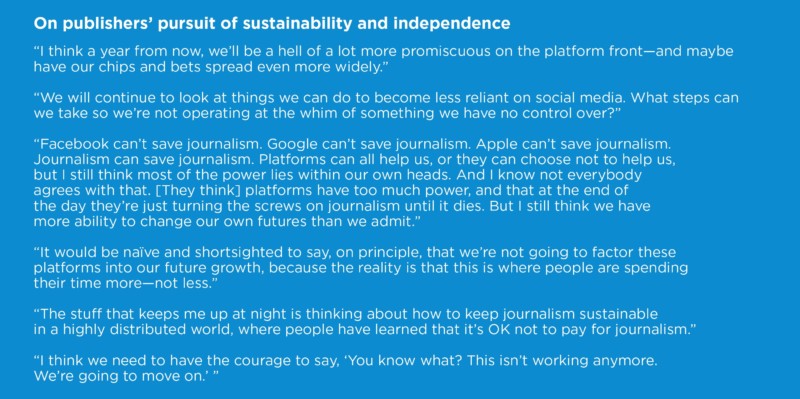
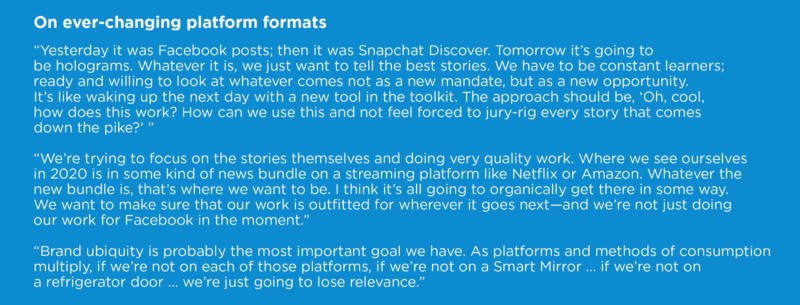
Conclusion
By Emily Bell
The evolution of the news ecosystem is of deep concern to everyone who wishes to see democratic principles preserved. Over the course of study, that evolution has been in crisis mode—and our research reflects this. Journalistic outlets remain rocked by constant change and uncertain revenues, just as platforms and technology companies find themselves answering hard questions from lawmakers and politicians on both sides of the Atlantic. Platforms, publishers, and journalists are all threatened in some measure by the vulnerabilities of the information environment and are, to some extent, bonded in a mission to overcome these liabilities.
As recently as three years ago we saw platform companies strenuously denying that they were active agents in shaping which information was shared and spread. They demonstrated a studied naiveté about their positioning as aspiring, major conduits for news, while maintaining platform “neutrality” over what was published and circulated. Now, however, Facebook and Google are directly funding journalism training, Apple is staffing up its own newsroom of editors and curators, and Twitter is soliciting ideas for improving the nature of public discourse.
In the same space of time, the publishers we studied also demonstrated a somewhat remarkable reversal of fortune. Advertising, both digital and analog, collapsed. Meanwhile, electrified by current events, consumers started to subscribe to publications, joining and supporting news with direct financial support in far larger numbers than was anticipated. Legacy organizations fared better than fragile, digitally native operations. Stability and reliability became more prized than innovation and disruption.
The civic concerns surrounding how technology companies shape our news and knowledge have become dominant, thereby making the relationship with journalism a critical component. Whether as a public relations exercise or out of authentic concern—or both— the launch of platform companies’ resulting initiatives has shifted both the perception and reality of their role. The pressure of congressional hearings, European legislation, and souring public opinion has seen Facebook, Twitter, and Google all commit more resources to curating their platforms. In mitigating risk for their own businesses, their actions have meant both positive and negative outcomes for journalists and news organizations. New products, design, and even financial support, albeit relatively small, have taken into account new publisher concerns. At the same time, algorithm changes aimed at elevating only a small subset of stories have had an equally negative effect on some news organizations.
As saviors of journalism, the platform companies have proved unreliable at best. However, the internal focus that companies have been forced to commit to better securing the information environment has led them to change their own priorities—and perhaps even their cultures. But these shifts toward a more active role in shaping the news do not mean that platforms are yet—or will ever be—journalistic. “Journalism will have to save journalism” is how one of our interviewees put it.
What we heard time and again from publishers was a hope that they could find a path to independent financial sustainability. But for this to happen, the platform companies would need to be more publisher-friendly in both their products and policies. Or publishers will have to be more resolute in carving out space away from social platforms. The requests from publishers are consistent: more transparency about how algorithms operate, more accountability for how journalism is presented and prioritized, more alertness around helping to develop business solutions, and more activeness in finding financial support.
The maturing of the platform press still has a ways to go. The structural problems in the news ecosystem are now widely acknowledged, and the price for not addressing them is dangerously obvious. But the best path forward is contentious even within companies themselves: more human moderation or a reliance on AI? A curated approach to news feeds or a preference for leaving it to personalization? Break up platforms under antitrust law or allow them to grow unchecked?
It has become clear that this relationship, this uneasy alliance between journalism and social platforms, contains implications that reach far beyond the business models of publishers. It’s now time to sort out the civic questions. And it goes without saying that journalism should not go soft on covering this all as it happens.
Appendix I: Workplace Analysis
By Elizabeth Hansen and Elizabeth Watkins
The late 1990s saw the rise of digital teams in newsrooms—teams that built, maintained, and published content to an outlet’s website. Digital news demanded a major shift in culture and workflow for legacy news organizations. For newspapers, the co-existence of digital and print operations was an uneasy mix, perhaps most memorably chronicled by the leaked New York Times Innovation report in 2014, which revealed ongoing tensions in workflow and priorities between the print and digital sides of the newsroom. “Born-digital” news outlets like Slate, BuzzFeed, and HuffPost, while not saddled with print operations, were often compelled by design to “feed the beast” and chase the traffic-based metrics of the open web.
The spread of social platforms is prompting another transformation in the operation and organization of newsrooms, with a new mix of culture clashes, workflow issues, and strategic dilemmas. This second inflection point for digital news—from the post-industrial digital press to the social platform press—is just as consequential as the first. In this chapter, we trace the outlines of this change at the workplace level from three angles: the rise of social media and audience managers, the mediating role of product teams, and the contextual influence of organizational governance.
Our study began with an open-ended inquiry into how platforms are impacting the workflows, roles, and organizational structures of newsrooms. To explore this topic, we studied three newsrooms in-depth, interviewing 20 people in platform-related roles between January 2018 and March 2018. Those interviews were conducted via video conference or in person. We conducted supplementary interviews by phone with an additional three executives at three more newsrooms in February and March 2018 to get a sense of variations in organizational structure by ownership type. We drew on workplace-related interview material from an additional 18 interviews conducted in 2016 as part of a larger, forthcoming study (to be published independently) for a sense of how the context of platform roles had changed. Our analysis paid particular attention to the dynamics of bridge roles—the people who work in between business and editorial functions in groups like audience engagement, social media, and product. It’s these people who are often in the position to notice, interpret, and implement changes in social platform functionality.
The cultural and operational status of social media in newsrooms
The growth of the platform press and the maturing of the publisher-platform relationship has spawned many new kinds roles inside news publishers—audience engagement editors, analytics editors, partnership managers, to name a few. But the first and arguably most important bridge role between platforms and publishers is the social media manager and their social media team. Social media teams fulfilled one of two types of functions in the newsrooms we studied: promotional and integral. (These are both our analytic terms, constructed for coding and analyzing the data and are not used inside newsrooms to our knowledge.) Promotional teams tended to be brought in at the end of a story production cycle to post and promote already-written stories. For these kinds of newsrooms, social media platforms functioned as just one more distribution channel.
This was often a source of frustration for social media managers, who could see the potential of social media for different types of storytelling and engagement but had trouble getting farther upstream in the story development process. One social media manager explained the dynamics within the newsroom this way:
“To someone who has been in the industry for a long time, these new platforms don’t represent a very exciting new canvas with which they can storytell. It represents something that almost diminishes their work. It’s been hard to change the workflow, because people feel like it’s against almost their morals and what they are here to do … it will mean that almost everyone in this newsroom needs to think differently.”
The cultural status of social media in newsrooms as, at best, a distribution platform and, at worst, a vehicle for cheapening journalism, makes it difficult for social media managers in promotional functions to find their way onto the calendar for editorial planning meetings. Even for those who managed to be included in editorial planning, it was sometimes hard to speak up and be heard. One social media manager, who was trying to move their expertise earlier into the story planning process, explained that the obstacles they faced were both cultural and operational: “Often, this constitutes changing not just hearts and minds but the nuts and bolts of how a story gets made, and making sure that social is part of the story calculus from the beginning, instead of tacked on as an afterthought.”
In the newsrooms that adopted a more integrated approach, the social media team was deeply involved in story creation from the beginning of the story cycle, often working closely with both assignment editors and reporters. One social media manager explained:
“When [an editor] is about to assign a story, we need to understand the vision of the story and brainstorm about different kinds of platform experiences that might work. Then when [they] assign the story we need to talk with that reporter about what they need to do. We need to make sure that what the reporter wants to do is a fit for the story and the social platform. While they are recording the story, we need them to possibly shoot vertical photos or videos from their iPhone for an Instagram story, or go live for Facebook Live, or make sure they are getting additional facts and more numbers, so we can make charts.”
The newsrooms adopting a more integrated approach to social media are grappling with a notable tension—how to translate their visual and storytelling style to platforms whose design constraints are often very specific. This goes beyond an issue of branding to questions of editorial voice and aesthetic style. The re-articulation of a publication’s spirit in social media form is becoming a key skill for social media managers.
Sometimes this re-articulation can run in opposition to the branding and design choices of editors who’ve risen in legacy newsrooms amid a culture of print publishing. This clash can create a bottleneck, where the work of translating branding to digital audiences poses not only operational workflow problems, but stylistic and editorial conflict. As one social media editor working in a legacy newsroom put it:
“That is the core problem I have to deal with … our designers [saying], ‘What you’re doing is wrong, let me the tell you how to do your job.’ [But] I’m constantly studying how well our things do. I actually do know what will work best on a platform.
I used to run our Instagram stories entirely on my own and would design myself, because we never had anybody else to do them. The Instagram CEO told our editor that our Instagram stories were wonderful … Now I have to run all of my Instagram stories through the design department and they have the final approval on everything I do. It screwed everything up. I’m actually going through a major crisis with it because I feel like we’ve lost our voice, because [what] design does … it’s so cookie-cutter. It’s for a younger audience. … I think our audience is probably less happy with our Instagram stories [now].”
Another trend we observed in our data was the differentiation and specialization of social media teams from single, general-purpose teams into a variety of platform-specific teams. This is especially true in newsrooms that have launched product-focused partnerships with platforms and those that have a significant video presence.
The popularity of Snapchat, in particular, with its specialized and intensive video production requirements, has prompted differentiation in social media teams. Snapchat has been observed providing specialized support to publishers who integrate Snap-specific teams into their newsrooms. This support, however, does not come without strings attached. One social media director at a legacy publisher voiced how easy it is to see the power differential between publishers and platforms when they’re all operating within the platform ecosystem:
“Snapchat [has] a lot of rules and they want to be quite heavy-handed in the editorial process, which I have a giant problem with. Sometimes they’ll have comments about what kind of a headline we should have, and what kind of photos we should run, and what kind of stories we should do. Their feedback is very helpful as long as it is distilling analytics. But increasingly it feels like they are not telling us about analytics; instead, they are telling us about what—editorially—they want their platform to be and what kind of stories to have told, and that is not something we’re particularly comfortable with.”
Meanwhile, another legacy publisher noted, “[There is] this sort of MO to dedicate editorial teams to platforms to figure out what works best specifically on that platform, but we don’t have that scale. For us it’s more about finding the right stories we should be telling for [our] audience and figuring out how to promote those better on each platform.”
Social media and the corner office
As the rest of this report makes clear, the platform landscape changes quickly. And these platform changes affect not only workflows but the descriptions of newsroom jobs. When we compared the titles held by a subset of social media-related interviewees in the 2016 wave of data collection to their titles at the time of this writing, we uncovered significant variation in naming conventions for social media roles and widespread job changes among the subjects.
Of 15 interview subjects, 10 had changed jobs, companies, or both. The heterogeneity of titles obfuscate, for the most part, whether these roles were promotions or lateral moves. Three were fairly clear promotions within the same company, but five moves to other companies came with these title changes: An audience editor became an engagement editor. An emerging media editor became a senior producer of social publishing. A social media director became a global social media audience lead. Such wide differentiation suggests that newsrooms have not yet settled into comparable patterns of core tasks and responsibilities, and suggests that job title is largely dependent on the publisher and the people who fill those roles.
One change we observed from 2016 to 2018 was a general rise in the prominence of social media expertise in newsrooms. Whereas most of the social media managers we talked to in 2016 were entry-level staffers and mid-level managers struggling with feeling peripheral in their newsrooms, in 2018 the strategic issues surrounding platform distribution are front and center in every newsroom executive’s mind. This doesn’t mean that every newsroom has been able to integrate social media into story production workflows, but it does indicate that those who have social media experience and can speak platform strategy are being promoted quickly.
A social media editor at a legacy magazine said, “I started as an assistant. I expressed interest and started helping with the social team and they promoted me, creat[ing] this role for me.” Another social media editor at a legacy newspaper noted, “We have a seat at the table. We’re really in these constant conversations about what is important to us and what is not—and we can really tailor what’s best in terms of analytics.”
In many ways this is no surprise, as platforms’ share of attention and traffic has only increased between 2016 and 2018, and social media audiences have become an integral piece of publishers’ business models. But the rise of social media managers to positions of newsroom leadership has been accelerated by organizational changes inside platforms as well. The last two years have seen platforms launch a variety of publisher partnership initiatives and publisher partnership teams. Responding to these changes has meant that many publishers have had to identify executives to vet opportunities and negotiate platform relationships. Thus, both the popularity of social platforms among news consumers and the proliferation of platform partnership opportunities have combined to raise the prominence of social media expertise inside publishers.
As a social media editor from a legacy newsroom told us, “At the end of the day they [platforms] have something that we [publishers] want,” meaning access to audience. “And they’re willing to work with us to give us access. We have to figure out how much are we willing to give them to get it.”
The creation of platform partnership roles and functions inside newsrooms is a remarkable development since 2016 and represents an institutionalization of the relationship between platforms and publishers. These functions were vital to the development of publishers’ abilities to represent and articulate their interests in the platform landscape.
Our research also found that while the reporting lines for social media are sometimes housed within editorial, in some cases they’re inside a separate department of “audience development” or “audience engagement.” These were two terms we heard very little of in 2016, but which are increasingly popular today. Their meanings vary from newsroom to newsroom, but in general these larger teams are serving as the bridge between journalism and the audience—advocating for both reaching audiences in various digital channels and for bringing audience stories, experiences, and reactions back into the newsroom. Newsletter teams, podcasting teams, and analytics teams are often included in audience development.
The role of product teams: Ground zero for digital strategy
Product teams play an often-overlooked role in the platform press landscape. In general, product teams inside publishers build and maintain the technologies that journalists use to create and publish digital content. Those products can be deep inside the technical stack of a publisher—whether in its CMS, the system of servers that archive its stories, or the APIs that push out and pull in other data sources. They can be within journalists’ tools for managing social posting, or even closer to the reader—experienced as the front-end of a publisher’s website or mobile application. Product teams can also work with the software that constitutes other digital publishing products like podcasts, videos, or newsletters.
The centrality of social platforms in the news distribution landscape has actually prompted an emerging class of news publishers with no publishing products of their own. These newsrooms (some of which are now vanishing) rely exclusively on social platforms for publishing formats and distribution. NowThis is one notable example. Cousins of these are publications, such as The Establishment, which rely on third-party publishing products like WordPress or the now-defunct Medium for Publishers for digital publishing. These newsrooms essentially outsource their product development needs to third-party developers. Most newsrooms, however, do own and maintain their own set of technical products that help them digitally publish and monetize their journalism.
The strategic importance of product teams was made particularly clear in our analysis after Facebook’s retreat from featuring news in its News Feed. In many newsrooms, product teams are in charge of handling the strategic shift to paywalls and subscriptions that is accompanying the collapse of digital advertising revenue for publishers. The skill and speed with which product teams can build, implement, and optimize paywalls will be a crucial determinant of which publishers are able to make subscription revenue a reality.
Yet product teams—sometimes even more than social media teams—are misunderstood inside newsrooms. The language they use, including phrasing such as “development cycles,” “user testing,” and “requirements,” etc., is foreign to many journalists. In addition, product teams often have to bridge the business interests of the publication (for advertising formats and paywalls) with its editorial interests (for storytelling formats and space on the homepage).
At the same time, product engineers likewise often misunderstand editorial values. We observed this especially in product-building teams that were physically positioned more closely to the business side of a publisher than its newsroom. As one product designer at a legacy print magazine said, “[Software engineers] get to decide what they build, and control exactly what they build—it’s like holding a magic wand. The other thing about these incredible engineers is, they have no idea what to build. They don’t understand publishing or monetization or reader relationships or anything. Their skill set is totally different from this. Again and again, [we see] choices made that don’t support storytelling.”
Product teams also maintain critical infrastructure for archiving, payments, and the composition of the news itself, all of which are visible to journalists only when broken down. When it comes to product teams, born-digital newsrooms have a true advantage. Digital-first newsrooms tend to have organizational structures and workflows built around the requirements of developing and maintaining digital publishing products. In contrast, the prioritization and product development routines in legacy newsrooms tend to reflect the publisher’s original distribution technologies (print or broadcast), often in ways that de-prioritize and de-emphasize the role of product teams.
The structure and functioning of product teams in newsrooms thus reflects a paradox of digital technology. On the one hand, with the rise of cloud-based infrastructure the costs of the computation and data storage which power digital publishing products have never been lower. Yet the time and labor costs of developing and maintaining specialized digital publishing infrastructure that is tuned to the particular needs of publishers oftentimes dwarfs the level of advertising revenue that a news organization can command. This makes bespoke product development inside all but the most well-resourced commercial newsrooms very expensive.
Software developers are expensive and software development takes time. Meanwhile, news publishers are both more variable in their particular workflows and cultures, and in size and scope than one single technical stack for publishing could possibly cover. All of this means the questions of “make or buy” and centralization or decentralization loom large over product teams in every newsroom.
In our data, we observed some corporate publishers opting for centralized product teams that serve a variety of their subsidiary publishing brands with what can feel to newsrooms like off-the-rack software. We saw other publishers (particularly digital-first) pouring large amounts of money and resources into product teams whose leads sit at the executive table with editorial leadership and have a hand in both crafting strategy and responding to editorial needs. This push-and-pull, between customization and scalability and between centralization and decentralization, determines the outer limits of the strategic flexibility of publishers in the digital world.
Governance and ownership
Our discussion of product teams points to the final and most important contextual influence on the organization and execution of publishers’ digital strategy: the role of governance and ownership structure in shaping the discretion newsroom leaders have in setting platform strategy. We observed that in highly corporatized news conglomerates, the growing strategic importance of both product teams and social media teams has meant that those reporting structures have migrated from the publisher brands up into corporate headquarters.
Business functions have almost always been consolidated in media companies (the economic rationale for such consolidation, after all). But what we are seeing is a consolidation of product, social media, and analytics also inside the corporate hierarchy. This doesn’t necessarily mean that social media and product development staff don’t “sit with” publisher subsidiaries, but it does mean that while the execution of social media and product strategy can live close to the newsroom, the setting of that strategy and its assessment are increasingly a corporate function. As one social media editor at a conglomerate-owned publisher explained, “With [Facebook] Instant Articles, it’s a decision that needs to be not just within the newsroom, but within the company. We’re working with our parent company to decide if it’s something we want to venture into. It’s a bigger decision than just saying, “Hey, let’s do some Instant Articles today.’”
Another social media editor told us, “The problem and the pain point is between differing corporate and brand visions.”
Appendix II: Journalist Survey
A study from The Tow Center for Digital Journalism at Columbia University Graduate School of Journalism and the American Press Institute
Conducted by NORC at the University of Chicago
Interviews: March 1–April 12, 2018
1,127 journalists
Margin of error: +/- 3.5 percentage points at the 95-percent confidence level among all journalists.
NOTE: All results show percentages among all respondents, unless otherwise labeled.
Q1–Q21 part of a separate study and released separately.
TOW1. Has your newsroom made major changes, minor changes, or no changes at all to how it produces news in response to the growth of social media platforms?
TOW2. Now, we would like to ask about your news organization’s resources. By resources we mean staff time or budget. Do you think your news organization spends too much of its resources, too little of its resources, or about the right amount of its resources focusing on social media optimization?
TOW3. Now, thinking just about Facebook, which comes closest to your view of how Facebook’s leadership feels about news on its platform? Choose which statement is closest to your view, even if it is not exactly right.
TOW4. When it comes to the news content that people see today, who has more influence, journalists covering the news or social media platforms such as Facebook?
TOW5. On the whole, would you say social media platforms such as Facebook have strengthened your newsroom’s relationship to its audience, weakened it, or have had no changes?
TOW6. Facebook changed its algorithm earlier this year to prioritize posts from friends and family in the News Feed, which may result in fewer publisher posts reaching audiences. How significant do you think the impact will be to your newsroom?
TOW7. In general, how much responsibility should social media platforms take for financially supporting quality journalism?
TOW8. In general, do you think that social media platforms have increased trust in journalism, decreased trust in journalism, or had no effect?
TOW9. For each of the following, indicate whether you think the company is doing more than enough, just enough, or not enough to combat the problem of fake news and misinformation on their platforms.
[items randomized]
TOW10. How sincere do you think each of the following companies is about wanting to help journalism and journalists?
[items randomized]
LENGTH1. Now a few questions about you.
How many years have you worked in the news media industry?
[open-ended]
LENGTH2. How many years have you worked for your current news organization?
[open-ended]
OUT1. Which of the following best describes the media outlet type of your current news organization?
NATLOC1. Is the news organization you work for primarily considered a national organization or a local organization?
JOB1. Which of the following best describes your current job title?
AGE. What is your age?
[open-ended]
LATINO. Are you of Latino or Hispanic descent, or not?
RACE. What is your racial or ethnic heritage? Please select all that apply.
RACE/ETHNICITY.
GENDER. How do you describe yourself?
Journalist Survey
This survey was conducted by NORC at the University of Chicago for the Tow Center for Digital Journalism at Columbia University Graduate School of Journalism and the American Press Institute. The survey was conducted from March 1 through April 12, 2018. Survey questions from this study were funded by the Tow Center.
To conduct a representative survey of newsroom personnel, a sample was drawn from a database of media contacts maintained by Cision Media Research (available to the public through a paid account). The sample was drawn along three dimensions—job title, outlet type, and whether the outlet was a national or local organization. Contacts from the following job titles were included in the sample:
- Assignment editor
- Calendar editor
- Editor
- Editorial coordinator
- Host/anchor
- News director
- Producer
- Program director
- Public service/community affairs director
- Reporter/writer
- Station manager
- Web content producer
Contacts with those job titles were then narrowed down to include only those who worked at outlet categories in the following groups:
- Cable/satellite—network/station
- Cable/satellite program
- Magazine, consumer
- Magazine, news and business
- Newspaper
- Newspaper publisher
- Newspaper, community
- Newspaper, neighborhood/classified
- Online, consumer (includes some news sites)
- Online, news and business
- Radio network
- Radio program
- Radio program, national
- Radio program, regional
- Radio station
- TV network
- TV program
- TV program, national
- TV program, regional
- TV station
- Wire service
Journalists were classified as working for either “major national outlets” or “minor national outlets/local outlets.” Major national outlets include the following, with all others classified as minor national outlets/local outlets. Websites of each of these outlets were also included as major national outlets (e.g., https://www.nytimes.com):
Newspapers:
- The New York Times
- The Washington Post
- USA Today
- The Wall Street Journal
Magazines (circulation of two million or greater based on Alliance for Audited Media 2017 data):
- Better Homes and Gardens
- Game Informer
- Good Housekeeping
- Family Circle
- People
- Woman’s Day
- National Geographic
- Sports Illustrated
- Time
- Reader’s Digest
- Cosmopolitan
- Southern Living
- Taste of Home
- Shape
- O, The Oprah Magazine
- Glamour
- Parents
- Redbook
- ESPN The Magazine
- American Rifleman
- FamilyFun
- Martha Stewart Living
- Real Simple
- Seventeen
Television:
- ABC
- CBS
- NBC
- PBS
- CNN
- C-SPAN
- MSNBC/CNBC
- FOX Cable News/FOX Business News
- Telemundo
- Univision
- ESPN/ESPN2
Newswires:
- Associated Press
- McClatchy Newspapers
- Bloomberg News
- Reuters
In total, 5,022 sample lines were classified as major national outlets and 72,514 sample lines were classified as minor national/local outlets. Of these 77,536 sample lines, 75,488 contained working email addresses. These 75,488 journalists from US major national and minor national/local outlets with working email addresses were mainly from the United States (all 50 states and territories) with some sample lines in Canada. They were all contacted by email to participate in the survey and interviews were conducted online using the Qualtrics platform. The survey confirmed eligibility (adults working for an organization that reports on the news). Respondents were offered a small monetary incentive (15 dollars) for completing the survey. All interviews were conducted in English.
The final sample is made up of 1,127 completed interviews with journalists, including 1,120 in the United States and seven in Canada. The response rate is 1.5 percent. The overall margin of sampling error is +/- 3.5 percentage points at the 95-percent confidence level, including the design effect. The margin of sampling error may be higher for subgroups.
Once the sample was selected and fielded, and all the study data had been collected and made final, a poststratification process was used to adjust for any survey nonresponse as well as any noncoverage or under- and over-sampling resulting from the study specific sample design. Poststratification variables included the type of media outlet the respondent worked for (television, radio, newspaper, magazine, online/digital, news wire, or other) and whether the outlet the respondent worked for was considered a national or local organization. The weighted data, which reflect the drawn sample of newsroom personnel, was used for all analyses.
For more information, please contact info@norc.org.
About NORC at the University of Chicago
NORC at the University of Chicago is an independent research institution that delivers reliable data and rigorous analysis to guide critical programmatic, business, and policy decisions.
Since 1941, NORC has conducted groundbreaking studies, created and applied innovative methods and tools, and advanced principles of scientific integrity and collaboration. Today, government, corporate, and nonprofit clients around the world partner with NORC to transform increasingly complex information into useful knowledge.
NORC conducts research in five main areas: economics, markets, and the workforce; education, training, and learning; global development; health and well-being; and society, media, and public affairs.
Appendix III: Interviews and Research Limitations
As with all studies, this one has its limitations. First, because much of our qualitative data come from interviews, some of what people shared may be reflective of retrospective sensemaking, and may not adequately capture the full range of strategic thinking about platforms that were actually in play in any given newsroom at any given time. Second, because the news media system in the United States has primarily been commercial and advertising-driven, our interview sample was heavily weighted toward large, commercial, text-based publishers and their relationship to social platforms. A minority of our interviews were with executives at small, nonprofit publishers and broadcast publishers. Thus, our findings reflect the predominant concerns and dynamics of large, commercial print-based publishers. We have noted in the text where variation exists in our data by publisher type.
Publisher and platform strategy interviews
Finally, because Facebook dominates so many layers of digital publishing, and has played such a visible role in shaping the dynamics of news distribution in the last two years, much of the data we collected on platforms is about Facebook specifically. That is not to say we did not ask about other platforms—Google News and Search, Twitter, Apple News, etc.—but the open-ended nature of parts of our interview protocol meant that a significant portion of our publisher interview data is focused on Facebook, because that platform was the one the publishers in our study most wanted to talk about. We have noted in the text where “platform” refers to Facebook, and where “platform” refers to other technology companies.
As far as our content analysis study, we only covered each publisher’s main account on each platform (e.g., we monitored @cnn but not the various other CNN-branded accounts, such as @cnnmoney). We did not include any Google products, such as AMP, nor did we include other notable products such as Twitter Moments. Platforms such as these were generally excluded due to the difficulty of monitoring new posts.
When collecting data manually, our analysis was limited to the posts that were served to our research devices, meaning we were forced to have faith that all of the articles posted to a publisher’s Apple News channel would be displayed when we opened said channel, as we could not cross-reference with data from an API.
The nature of content posted to individual platforms is also often inherently different from one platform to the next. We were therefore forced to compare unlike products, to some extent. For example, a tweet or retweet on Twitter would add one post to a publisher’s weekly tally, just as a Facebook Live video would, despite the former requiring considerably fewer resources. Ultimately, the overall objective of this project was to gain a broad overview of how these publishers’ distributed content strategies evolved over time.
Our analysis was likewise limited to the volume of posts made by publishers. There is obvious scope to supplement this analysis with research into the qualitative content of posts made to social platforms.
Acknowledgments
The Tow Center would like to thank everyone who participated in this Platforms and Publishers project over the years. This research would not have been possible without those individuals working in newsrooms and at platform companies who gave our team hours of their time for interviews, and were thoughtful, open, and generous amid busy schedules.
We are likewise grateful to each of the participants and panelists in our roundtables, policy exchange forums, and conferences. Their insights and exchanges during sometimes daylong discussions were invaluable to our team. And, of course, thank you to those who hosted the forums—from Harvard’s Shorenstein Center on Media, Politics, and Public Policy on the East Coast to to Stanford’s Brown Institute for Media Innovation and USC’s Annenberg School for Communication and Journalism on the West Coast.
And for bringing this phase of our research over the finish line, we want to recognize our tireless Tow fellows who read (and reread) this report, offered suggestions, and provided feedback. Thank you especially to Priyanjana Bengani for shepherding and lending sense to our massive newsroom survey with the American Press Institute and NORC, and to Jon Keegan for his keen data eye. Also, thank you to our former Platforms and Publishers project director, Meritxell Roca-Sales, for orchestrating the policy exchange forums across the country, and for guiding the project along the way.
Above all, thank you to the best editor a team could ask for, Abigail Hartstone, who spent nights and weekends alongside our team, pushing us in debates and discussions, masterfully sculpting every part of the report’s structure, and challenging word choices and comma placements along the way. This report would not be what it is without your wisdom, guidance, and patience.
Finally, we would like to extend our greatest thanks to our funders, who made the Platforms and Publishers possible through their generous support: John D. and Catherine T. MacArthur Foundation, Open Society Foundations, John S. and James L. Knight Foundation, Abrams Foundation, and Craig Newmark Philanthropies.
Nushin Rashidian, Pete Brown, and Elizabeth Hansen — with Emily Bell, Jonathan Albright, and Abigail Hartstone —are the authors of this report. Nushin Rashidian is the research lead on the Center’s Platforms and Publishers project. Pete Brown and Elizabeth Hansen are senior research fellows at Tow. Emily Bell is the Center’s founding director, and a leading thinker, commentator, and strategist on digital journalism. Jonathan Albright is the research director at Tow; his work focuses on the analysis of socially-mediated news events, misinformation and propaganda, and trending topics. Abigail Hartstone served as lead editor on this report.



